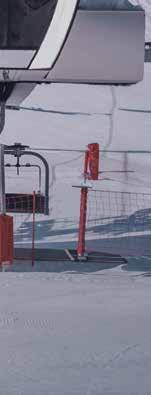




Grâce à une technologie intelligente et connectée, nos téléphériques sans personnel d'exploitation en stations redéfinissent les standards de sécurité et de fiabilité, aussi bien dans les zones touristiques que dans les environnements urbains. Des caméras et des capteurs de pointe assurent un fonctionnement 100% autonome, tandis que le Poste Centralisé de Contrôle (PCC) garantit une supervision en temps réel pour une disponibilité maximale.
L'AURO "Autonomous Ropeway Operation" combine innovation technologique et expertise humaine pour redéfinir l'avenir de la mobilité par câble qui peut être étendue à plusieurs systèmes avec un seul Poste de contrôle.
doppelmayr.com

The mountain is not a steady, unchanging landscape... it too must carve out new paths for the future. In this respect, 2025 could represent a decisive turning point as it features a series of unique challenges and opportunities which are now emerging with increasing clarity.
Challenges and opportunities in the fields of circular economy and sustainability, both clearly identified as central to all industry discussions and increasingly spawning innovations that are transforming equipment and infrastructure, making them more virtuous.
Challenges and opportunities in the ever-changing mobility sector with the emergence of greener solutions that are better suited to the demands of the mountainous regions. More visitors heralding the success of newly installed facilities are a perfect reflection of this dynamic.
Challenges and opportunities in integrating modern equipment into the landscape by updating the design of cabins, towers and stations, now seen as architectural assets, blending aesthetics with functionality. There is also a fresh perspective on the design of ski lifts...
Technical and technological challenges and opportunities, but also societal ones with solidarity among stations strengthening the response to collective economic and environmental issues. In this context, environmental observatories play a key role, helping to anticipate and measure the effects of climate change on our mountains, informing our decisions around management and development.
Challenges and opportunities related to the fast-approaching Winter Olympic and Paralympic Games in 2030 hosted in the Alps, providing an extra incentive to reimagine the white planet.
Finally, challenges and opportunities for all those involved in mountain development around the world, and who Mountain Planet is so proud to welcome to Grenoble every two years. The metamorphosis underway is fuelling a powerful growth, one that has become more value-driven and aware of environmental requirements. A growth that is more diversified due to urban and leisure ropeway transportation and more geographically diverse, with projects in even the most unexpected destinations. These trends reflect the very essence of the “challenges and opportunities”, two words that support our analysis and may well guide our path forward in the years to come.
Managing Director of ALPEXPO, Grenoble’s events park

Simone Bramante - Skyvertigo ©Skyway Monte Bianco
INNOVATION BOOK IS PUBLISHED BY MOUNTAIN PLANET ALPEXPO
Publication Director: Jérôme Riff, Managing Director ALPEXPO, Grenoble’s events park
Coordination: Nadine Chevalier, Mountain Planet
International Exhibition Project Manager
Press officer: Alexandre Bérard, Alternative Média

PRESS OFFICER
EDITIONS COSY
GERANT : Claude BORRANI
SAVOIE Technolac
18, ALLÉE DU LAC ST ANDRÉ
73 382 LE BOURGET DU LAC CEDEX
Tél : 00 33 (0)4 79 65 46 10
Fax : 00 33 (0)4 79 65 46 12
Site Internet : editions-cosy.com
Editorial
Marie-France Sarrazin - Cécile Ronjat
Claude Trinidad - Véronique PilonAude Pollet-Thiollier
Translations
UK and GER: ACS Traduction
Art direction & design
Séverine Béchet • studiosbdesign.fr
Advertising
Fanny Marguet fanny@cosy-editions.com
Frequency: Annual
Impression
TYPO LIBRIS
37, avenue des Châtelets 22440 PLOUFRAGAN
FRANCE
Legal Deposit: upon publication
ISSN 2418-0297
Any reproduction or representation in whole or in part by any process whatsoever of the pages published in this magazine without the publisher’s permission is unlawful and constitutes an infringement. Only reproductions strictly reserved for the private use of the copier and not intended for collective use, and short quotations justified by the scientific or informative nature of the work in which they are incorporated, are authorised (art. L.122-4, L.122-5 and L.335-2 of the French Intellectual Property Code).



LATEST MOUNTAIN NEWS AND INNOVATIONS
MOUNTAIN PLANET
ANALYSIS
Every year, Laurent Vanat carries out an in-depth review of the international snow and mountain tourism industry. What are the key takeaways for 2023-2024?
FOCUS
When China awoke... Widely considered a very promising country for growth in the mountain development market, could China become a key industry player?
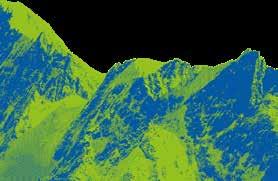
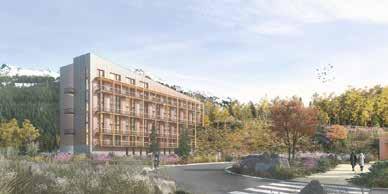
Expanding and acquiring ski areas is clearly an integral part of the strategy pursued by Vail Resorts and its direct rival, Alterra Mountain Company. After snapping up Andermatt and Crans Montana, the group is training its sights on other alpine targets. Read on for an analysis of a powerful acquisition strategy that could change the economic landscape of Europe’s winter sports sector.
TRENDS
Morocco, India, Pakistan, Africa, Middle East... the countries breaking into the market have clearly caught the eye of the sector’s players. Poma, MND, Kassbohrer, Dopplemayr, Sunkid, TechnoAlpin and HTI open up about the initiatives that they are leading in these countries.
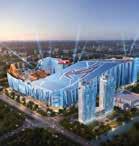
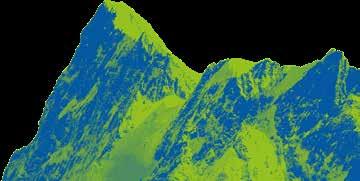
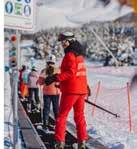
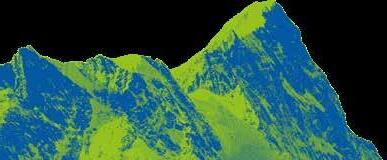
REVIEW
Close-up look at the investments for France’s ski areas in 2024.
MOBILITY
Could the Lyon-Turin rail link and Saint-Jean-deMaurienne international train station spell an economic windfall for the valley and its resorts?
DESIGN
When cable car stations provide inspiration.
CIRCULAR ECONOMY
Circular economy principles permeate every part of Serre Chevalier’s daily management practices
ENVIRONMENT
• Initiatives to restore ski pistes and open environments in the mountains. Read on for an explanation...
• Environmental observatories: what purpose do they serve and which ski areas have adopted them?
• Heating premises using calories from ski lifts is possible!
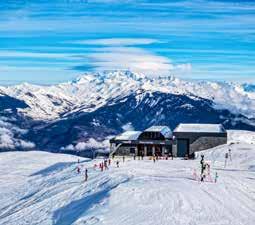
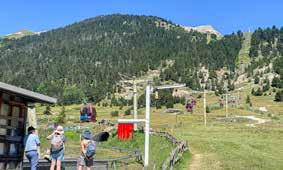

Ski lift renewals: gondola lifts surge in popularity as a way of developing business in both the summer and winter.
SOLIDARITY
In the face of change, the mountain world bands together.
2030 WINTER OLYMPICS
The hopes of prosperity nurtured by the Hautes-Alpes department after years on the sidelines of the country’s urban design programmes.
Interviews
• Fabrice Pannekoucke, President of the Regional Council of Auvergne-Rhône-Alpes
• Damien Robert, CEO of SOLIDEO
Mountain planet 2026 on the horizon.





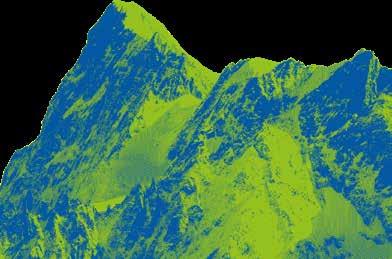

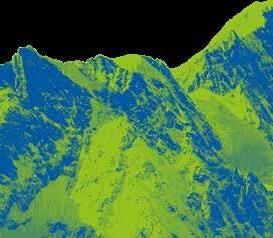
New President of Domaines Skiables de France (DSF)
“We need to innovate in several areas and compensate for our weaknesses”
CSR will be a focal point of your stint as DSF’s President. Which areas will be at the top of your priority list?
We’ve gone ahead with the decision to set up a CSR division supported by three committees. One of those committees is focused on our employees. Our number of work-related accidents is clearly higher than in other sectors that are also well known for being prone to accidents. Early February, we arranged the first bespoke training course for resort executives to discuss the following question: «What measures can we all take together to bring the accident rate down?» We’re not starting with a blank canvas, because all the resorts have already taken various steps to curb accidents. It often happens that we manage to drive down the number of
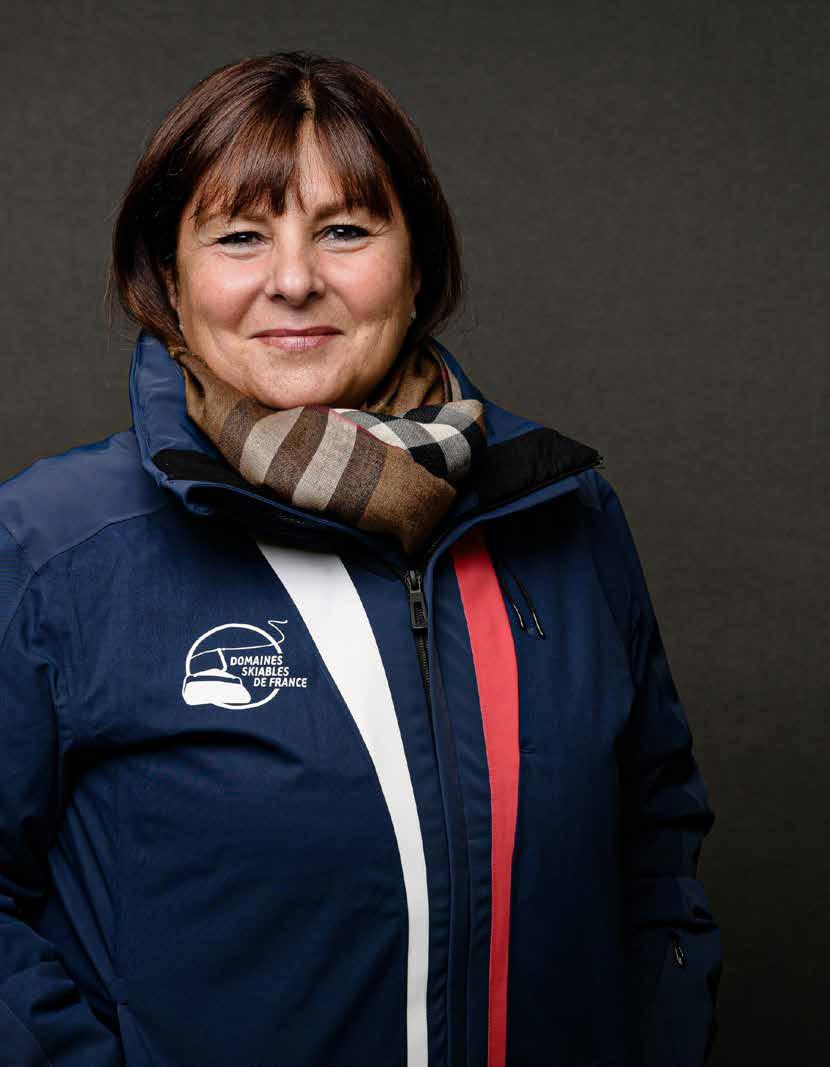
accidents during the first year, only for that figure to start creeping up again the following year. It’s not a question of resources and commitments. It all comes down to management practices.
The environmental committee is responsible for reducing our carbon footprint, keeping tabs on our environmental commitments, and addressing other related areas, like water use, snow production and fuel. We’re currently taking an in-depth look at our water resources.
What are your strategies for taking your environmental performance to the next level?
A quick and effective way of striving towards net zero involves using HVO biofuel in the snow grooming vehicles,

but it’s a lot more expensive. Working on environmental issues is also a time-consuming process.
That’s why we’ve set up an outreach committee to act as an interface between the other two committees and especially help those resorts whose lack of financial resources and manpower is holding them back from achieving their environmental commitments. Some of our 250 member resorts are facing shortages in their permanent staffing levels. All these issues are typically dealt with during the low season, but they’ll never be addressed if there aren’t enough permanent employees or even none at all. The idea is based on delivering pragmatic support to the resorts, such as reviewing and correcting business plans or income statements, examining opportunities for improvement, and helping renegotiate and spread out debt payments. DSF has been offering financial solidarity to its members for 20 years through its Nivalliance policy (an insurance policy providing cover for climate-related hazards). Often all it takes is a little tweak to keep a company afloat.
Are there any other challenges going forward?
We have a window of six to eight months to wrap up our projects. If you miss the boat, then you’re looking at another year. We can end up in the most ludicrous situations where we can’t even get our projects off the ground.
We need to be agile.We’re business leaders. We help sustain all the mountain communities. Take away that economic growth, and certain areas will end up deserted. We need to preserve our mountain facilities and infrastructures. I’m not saying you should do just anything.
We need to pursue the best possible development plan.
Where does innovation fit into the picture when managing a resort?
We need to innovate in several areas and compensate for our weaknesses. We need to bring in electronic ticketing and switch over to a new model for selling passes and allowing customers to access the resorts with their phones.
When it comes to
incorporating innovative technologies into our ski lifts, I’ve seen some very positive things. Construction firms have embraced eco-design principles.
Simplification is the first one that comes to mind, because developing the mountain region is key to maintaining thriving communities, but building infrastructures and facilities is increasingly becoming an uphill battle. Before you can go ahead and swap out an obsolete energy-hungry ski lift featuring 25 towers and a capacity of 600 people an hour with a new energy-efficient ski lift in exactly the same place with 10 towers and a capacity of 2,400 people an hour, you need to carry out a new global impact assessment, just like if you were building on undeveloped land! There always tends to be a snag somewhere down the line, and we often have to respond to planning objections that slow down the process.
Our profession generates 60% of its revenue over a period of only six weeks, meaning the holidays in February and at Christmas, so we can’t take the slightest risk.
The whole ticketing system not only needs upgrading, but it also has to be ultra-secure. I feel as though we’re struggling to strike the right balance between our need for reassurance and our need for development. It’s the same thing with data. There’s major room for improvement. When it comes to incorporating innovative technologies into our ski lifts, I’ve seen some very positive things. Construction firms have embraced eco-design principles.We’re also focused on bringing innovation into the other activities that run parallel to skiing. Our customers obviously come here for the skiing, but they enjoy the other leisure activities on offer. We want to enhance customer satisfaction and maximise their loyalty so that we can keep our ecosystem thriving.
WHAT’S NEW?
The cable car between Zermatt and Furi was built back in 2023. In the summer, visitors were treated to a new rooftop ride experience. A balcony has been fitted to the roof of the cable car, so that customers can take in the magnificent views over the Matterhorn.
In the summer, cable car customers can truly experience the wind rushing through their hair.
SATA Group, the company that operates the Les Deux Alpes resort in France’s Isère region, closed one of the largest cable car investments that the world has ever seen when it replaced the 1985-built Jandri Express with the Jandri 3S, which was unveiled during the winter. Featuring all the hallmarks of Poma’s engineering expertise, the cutting-edge Jandri 3S guarantees stability and comfort even in the harshest weather conditions and is designed to run in both the winter and summer. This two-section tricable gondola lift speeds across 6.4 km and a 1,480-metre elevation gain in a mere 17 minutes compared to the previous 40-minute journey with the Jandri Express. The dual direct drive system is capable of reaching 8 metres a second, meaning that the Jandri 3S can carry 3,000 passengers an hour, which is twice the previous rate. The 55 cabins have been designed by Italian firm Pininfarina and can seat 24 passengers, together with standing room for 8 people. A connected screen streams information about the ski area in real time. In all, over 40 km of cables have been installed! As for the new gondola lift’s environmental credentials, the number of towers has been reduced to 7, compared to the 17 towers with the previous model, and the lift runs without the use of hydrocarbons, which helps trim 5% off its electricity consumption while limiting noise emissions.
The Jandri 3S was commissioned during the winter. ©Lionel
Royet
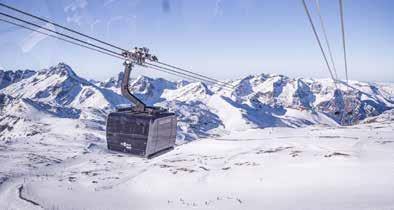
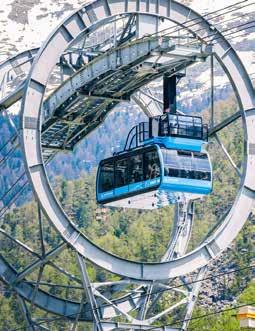
Last September, US startup M1 publicly unveiled its all-aluminium skis on the slopes in Zermatt, which are designed from a single solid block of aerospace-grade aluminium alloy. With their flexible and rugged design, these skis are capable of withstanding the most extreme conditions, while delivering a smooth and quick ride. They are also fully recyclable. The company has already started taking reservations. The first pairs will be available in the autumn and are expected to carry a similar price tag to high-end skis.
These all-aluminium skis from US startup M1 will be available in the autumn.
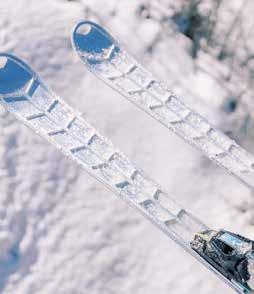
That is exactly what the new detachable Roches-Blanches chairlift in Val Cenis contains. The lift was commissioned during the winter and mainly comprises relatively recent parts that were purchased secondhand from other resorts. This strategy has been instrumental in reducing the use of raw materials by 90%, while producing 10 times less greenhouse gas emissions. The chairlift was assembled by Poma. The new lift tips the scales at 400 tons, but only 35 tons of materials were specifically produced for this project. After providing 35 years of faithful service, the old chairlift has been dismantled with the aim of preserving as many parts as possible, so that they can be sold and used again. To complete this virtuous circle, nearly all the parts that cannot be used are recycled instead.
Used parts account for 90% of the new Roches-Blanches detachable chairlift.
©Val Cenis

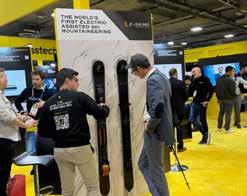
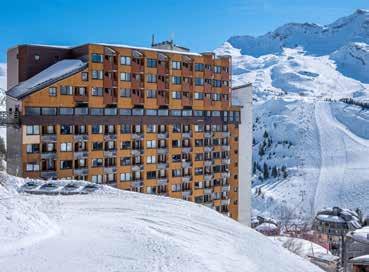
Pierre & Vacances is spending €20 million on refurbishing L’Hermine, an iconic 16-storey building in the resort of Avoriaz. Built in 1975, this former timeshare property will be renamed Capella. The renovation programme is clearly aimed at improving the building’s energy performance and slashing its annual energy use in half from 353 kWh/m2 to 157 kWh/m2, which will play a key role in obtaining BBCA certification (low-carbon building).
Pierre & Vacances intends to keep the existing timber enclosure, which will be maintained. All the windows will be replaced, while the interior will be dry-lined with a system of timber framed walls and rock wool insulation. The building will continue to be heated by electricity, but using smart and connected systems offering greater efficiency and consuming less energy. The pool will be covered to reduce energy losses even further. A survey was conducted before work began with the aim of identifying the plastic, glass wool, metal, wood and plaster that could be salvaged and reused. Over 13 tons of products (electrical appliances and sanitary fittings) have been forwarded to a reuse platform, where they will subsequently be sold to private individuals or businesses, or donated to associations. The 143 units (measuring 33 m2) will keep the same layout, but will be given a makeover. The project began in September 2024. By December 2025, Pierre & Vacances will be able to deliver half of the residence.
The entire building is due to open in December 2026.
We are all familiar with electric bikes and scooters, but now there is a new kid on the block in the form of electric touring skis. Swiss company E-outdoor has developed the E-Skimo system, which enables skiers to climb up to 80% faster while reducing muscle effort by 30%. Each ski is fitted with a small motor and a battery. A removable rubber tread attaches beneath the ski. The entire system is connected to a number of sensors for switching the motor on and off as required. When the time comes for downhilling, the motors and batteries can be removed.
The system was presented earlier in the year at the CES trade show in Las Vegas. ©E-outdoor
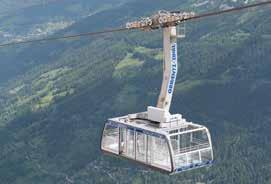
Boasting a glass floor, ceiling and walls, the Alpine Top was opened to the public last summer in Grimentz-Zinal, Switzerland. Designed by Garaventa, the cabin provides a 10-minute ride between Grimentz and Espace Weisshorn, and promises a fully immersive experience in the heart of the natural landscape in Val d’Anniviers.
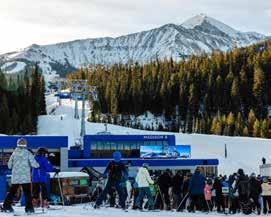
On 20 December 2024, Big Sky Resort in Montana, USA, lifted the curtain on Montana 8, the world’s longest eight-place chairlift, covering just over 2.6 km. Designed by Doppelmayr, the chairlift is capable of reaching the summit in only 8 minutes, compared to the 12-minute ride with the previous lift. The latest-generation steel rope reduces strand-induced vibrations, while the heated seats and bluish bubbles with their panoramic views guarantee an even more comfortable ride.
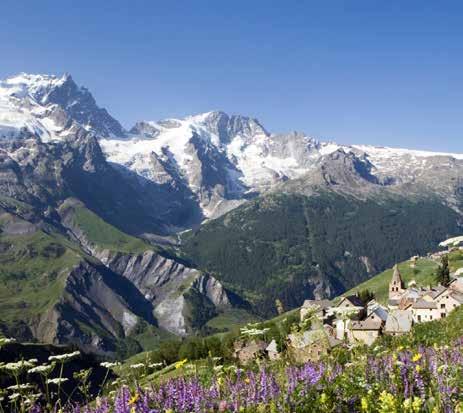
The number of people drawn to the mountains to satisfy their need for outdoor activities is surging at a time when the mountain environment is continually falling prey to the effects of climate change. As extreme weather events strike with ever greater intensity and frequency, and especially in the wake of the devastating floods that carved a path of destruction through the Ecrins National Park in recent months, the park’s managers have decided to launch a new collaborative portal. This one-stop platform is designed to aggregate and disseminate information about the conditions and risks in the high mountains for the benefit of the general public, just like the system developed by the La Chamoniarde association to provide details about the latest conditions across the Mont Blanc massif. Therefore, this platform is aimed at offering specific and accurate information based on the observations and insights provided by various mountain professionals (PGHM and CRS Alpes mountain rescue services, Météo France weather service, the mountain restoration branch of France’s national forestry office, high-mountain guides, ski hut wardens, etc.) about the quality and accessibility of the various trails for hikers, ski touring enthusiasts, snowshoe-trekkers, mountaineers, climbers, and so on. The platform will cover the whole park, which straddles the dividing line between the Isère and Hautes-Alpes, before it is scaled up to encompass both regions in their entirety to meet the needs of people whose roaming activities take them further afield.
The number of rock instability events across the Mont Blanc massif has more than doubled since the turn of the 20th century, as revealed in a study conducted by researchers at ISTerre (Institute of Earth Sciences) and EDYTEM (Laboratory for Mountain Environments, Dynamics and Territories), both of which are affiliated with the Grenoble Observatory for Sciences of the Universe, and the Biogéosciences laboratory. Their findings, which have been published in the Earth and Planetary Science Letters journal, show that this increase in the rockfall rate is caused directly by the climate crisis.To quantify how the climate crisis has affected the erosion rate, researchers combined two complementary approaches, namely a detailed inventory of recent rockfall events and an analysis of natural geochemical markers. Between 2007 and 2011, a network of mountain professionals recorded all rockfalls greater than 100 m2 occurring in the upper Mer de Glace basin as part of a participatory science initiative. To study the smaller rockfalls, researchers used Lidar, a remote detection technology that uses laser beams to accurately measure movements and distances in real time, which enabled them to identify the areas where rock fragments have come loose over time. At the same time, debris from old rockfalls was analysed to gain a clearer understanding of the intensity involved in previous erosion processes. The results reveal a sharp acceleration in erosion levels. Erosion rates across the massif have doubled from less than 2.2 mm/year at the beginning of the 20th century to more than 4.1 mm/year between 2006 and 2011.

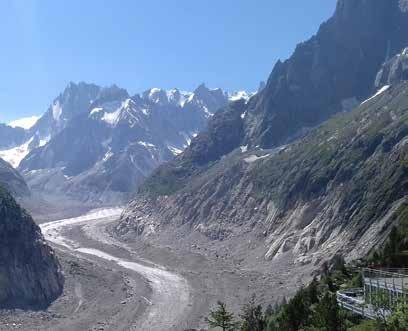
To coincide with the Mountain Planet show one year ago, MND offered a sneak preview of its new cable transport range called Orizon. The French group has sold the first model (a 10-place gondola lift) to the Chimgan resort in Uzbekistan, which will enter active service in December. In actual fact, the very first model was installed at MND’s head office in SainteHélène-du-Lac (south-eastern France). Featuring two stations, three towers and two cabins (which can be increased to six or seven), the demonstrator has been running for almost 24 hours a day since 3 December, which is like cramming 10 years of normal service into just four or five months to prove its design with this life-size test model. Customers are delighted to discover this “extraordinary” machine in operation. “Bearing in mind that we’re something of a newcomer in the market, this demonstrator proves that we know what we’re doing,” explains Nicolas Chapuis, Deputy Chief Executive of MND. The group already had a certain amount of experience in the field after forging a partnership with Swiss ropeway manufacturer Bartholet, and leading several projects in France, the United States and China. This demonstrator also provides the ideal opportunity to prove the lift’s performance “in line with best market standards at seven metres per second. We’re also the first to offer a 20-place cabin on a single-cable gondola lift.”
By reducing its bank debt by half since 2018 and investing more than €90 million into upgrading its infrastructures with a €40 million subsidy from the European Regional Development Fund (ERDF), the Andalusian ski resort of Sierra Nevada has pulled off an incredible feat in transforming its finances over the last six years, despite the health crisis. Public company Cetursa has forged ahead with a number of strategic decisions, such as renovating the Al Ándalus gondola lift for €20 million, building a snowmaking centre aimed at driving down energy costs, installing new snow guns and ski lifts, setting up a conveyor belt for beginners, rolling out a digital access system, and creating a new customer service centre. Sierra Nevada has also renovated its four-storey underground car park, renewed its snow guns and purchased a new fleet of snow groomers. These efforts have culminated in a virtuous circle, since the resort enjoyed its highest ever visitor levels last winter, even though weather conditions were not always conducive to skiing. Since they say that you should never change a winning formula, Cetursa is developing a number of new projects to modernise its facilities and diversify its activities, while giving greater focus to the summer season. Cetursa is looking to set up hiking and mountain bike trails, astronomical observation circuits, and summer camps. As part of its ongoing determination to improve efficiency and save energy, Sierra Nevada is thinking about installing snowmaking systems that use less electricity and water, while continuing to digitise its services.
Savoie locals Renaud Vézier and Pierre-Yves Prost used to work for a snow groomer manufacturer before striking out in 2023 and creating AllTracks Engineering, a company that gives a second lease of life to snow groomers, which are only used for an average of seven years on the pistes. The young firm reconditions and repurposes scrapped snow groomers to serve the agricultural and forestry sectors. This solution makes perfect environmental sense by avoiding the 55 tons of CO2 emissions that would have been generated in producing a new machine, not to mention the fact that these converted machines cost two to three times less than a tractor.
Reconditioned groomers are ideally suited to biogas sites, spreading applications, grinding operations in damp areas, log hauling in forests, and much more besides. With their major climbing ability and pushing performance, tremendous power and speed, and low ground pressure, groomers offer safe working conditions whether operating uphill or downhill.
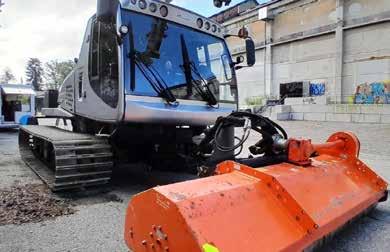
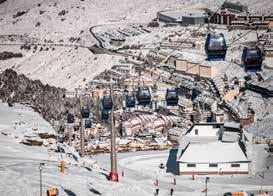
Through a combination of debt reduction measures and strategic investments, the Andalusian resort has created a virtuous circle
Head has just launched its Renew range of skis incorporating a combination of renewable and recyclable materials. Customers can return their used skis. The Austrian brand will reuse the wood core, glass fibre layer and tip protector to design another pair of skis, while recycling all the other materials.
The Alpes Tourisme Lab business incubator has chosen Logements 2 Saisons to be one of the six startups that will receive its support and guidance in 2025, as it pursues its aim of creating and shaping the mountain tourism industry of tomorrow. Finding somewhere to stay can be a major headache for seasonal workers, so Logements 2 Saisons has developed a secure platform that simplifies the search process by connecting owners and workers.
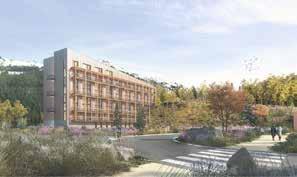
«Over the years, construction projects for tourism infrastructure and accommodation have been thriving in the Tarentaise area, but unfortunately there hasn’t been any housing policy to accompany that trend,» advises Guillaume Desrues, the Mayor of Bourg-SaintMaurice. As permanent residents and seasonal workers grapple with the problem of finding accommodation, Guillaume Desrues has decided to tackle the problem head-on. In 2024, local councillors gave the thumbs up to the proposal of setting up a public-private partnership (called «Semilab») involving the municipality (the majority shareholder with a 51% interest), Compagnie des Alpes, Savoisienne Habitat, AB Tourisme, Crédit Agricole, Caisse d’Epargne and the hospital. Semilab aims to create 120 housing units by 2031. The first 60 units will be delivered in July 2026 in the La Croisette district of the Arc 1800 resort and will be capable of accommodating up to 100 seasonal workers with much lower rental fees than the private market. The consortium led by architecture firm Atelier 419 has been awarded the contract to build this sustainable, energy-efficient building. Project value: between €9 and €10 million. Planning permission has been granted, and work will start on the foundations late April. Semilab is looking to develop other projects on a smaller scale (15 to 30 housing units) that will preferably be built in the Tarentaise Valley. These units will prioritise people working in the public and semi-public service sector, while other tenants will be chosen at random.
Val Cenis is the first resort in France to invest in an all-electric snow groomer, namely the Husky E-Motion from Prinoth, at a cost of €350,000. Located in the Haute Maurienne valley, the resort has a fleet of nine fuel-powered snow groomers and an electric snow groomer that entered active service during the 2022/2023 winter season to replace a small machine that had reached the end of its service life. «The idea of using an electric snow groomer dovetails with our sustainable development policy, the 16 environmental commitments pledged by DSF and our Flocon Vert certification. We’re only too willing to try out this type of equipment, and Prinoth is eager to receive constant feedback to improve its
machine’s performance,» explains Morgane Gauché, Communication Manager. This electric snow groomer is used to prepare the cross-country pistes, pedestrian trails, play areas and sledge runs, which tend to be relatively flat and located near the charge points. Not only does the Husky E-Motion make no noise, but it also boasts the huge advantage of not burning through 13 litres of fuel for every hour in service. It also drastically reduces CO2 emissions to 10 times less than before. But certain organisational measures must be taken on account of its lower run time (three hours). It also struggles with steep gradients. For the time being, the resort does not need to renew any of its other snow groomers. «When the day comes that we can replace a large diesel-powered snow groomer with an equivalent electric model, then we’ll definitely be interested,» says Morgane Gauché.

in France to invest in an all-electric snow
The SuperBagnères resort in the Pyrenees is trialling the seamless and obstacle-free OpenGate access control system developed by Intence, which instantly detects any attempted fraud, such as people trying to share ski passes or access unauthorised areas. With this solution, visitors can simply walk up to the ski lifts without having to first pass through a turnstile or get stuck in a queue, since they are identified by artificial intelligence.

During the summer of 2024, Avoriaz decided to trial the Back Roll system designed by Partech. This aluminium frame is designed for easily loading and unloading mountain bikes on any type of chairlift. The system is capable of seamlessly, quickly and safely transporting between two and four 20” to 29” bikes by holding both wheels on the rack.
Avoriaz successfully trialled the system during the summer. ©Partech
The Massif des Bauges Regional Nature Park has implemented its new policy featuring 23 measures aimed at mitigating the effects of climate change and adapting to an increase of 2.3°C over the next 60 years and predicted warming of 1.5 to 2°C by 2050 for those areas where temperatures are rising faster than elsewhere. Rising temperatures could lead to a 20 to 25% reduction in snow cover across the French Prealps. The park’s mid-altitude ski resorts are already bearing the brunt of climate change and have therefore started migrating towards an all-season tourism model. The new policy will endorse investments in projects designed to promote activities that are unaffected by snow conditions while developing tourism activities that allow visitors to discover the local region.
“The tourism sector in our local region will progressively embrace a wider range of activities covering every season and introducing visitors to what is still an unspoiled area. The aim is to keep jobs safe, protect the natural environments, keep a close eye on visitor levels and guarantee society’s acceptance of this new tourism model. Revenue from our tourism activities will go towards protecting the sensitive natural environments and educating about the local region,” explains Dominique Pommat, Vice-President of the “Municipalities of Savoie”.
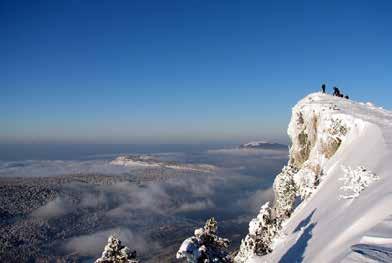
“When it comes to moving the energy transition forward, we’re doing what we can at our own level, but the real challenges revolve around organising the tourism sector. The gains could prove to be huge if visitor levels were evenly spread out. We’ve noticed that there are more and more spikes in those levels, which not only makes for a less enjoyable holiday experience, but also requires us to invest in what are sometimes oversized infrastructures. The system for dividing up France into different holiday zones is failing to strike the right balance, and no consideration is given to the dates when other European countries are on holiday. This leads to traffic jams on the roads and excessive fuel use, as well as overloaded trains, which deters people from using rail travel. If holiday start and end dates were spread across every day of the week instead of just one day of the week, we could increase rail capacity by a factor of six.”
PATRICK ARNAUD, Chief Executive of the Serre Chevalier ski resort

The decision to create the Pyrégraine de Nèou mark in 2010 was prompted by two observations made by the national botanical conservatory that works on restoring damaged ecosystems across the Pyrenees and Midi-Pyrénées regions. Firstly, commercially available seeds are not always suitable for planting in areas at altitudes above 1,500 metres. Secondly, efforts must be made to avoid introducing genetic pollution into these vulnerable areas and contaminating their species. That explains why it is so important to work with local, wild seeds.
“We were really short on resources for marketing this idea. That’s why we set up the Pyrégraine collective mark,” says Manuel Delafoulhouze, Head of Ecological Restoration at the Biological Conservatory.
Since 2020, the Pyrégraine de Nèou mark has been modelled on the national “Végétal local” label that belongs to the French Office for Biodiversity.
Eight Pyrenean producers have been awarded the label. Local wild seeds really come into their own for recreating meadows, lawns, and so on, after earthworks, a landslide or erosion. Manuel Delafoulhouze is promoting the concept and the value of choosing local seeds, especially among ski areas which continue to be the main driving force for development in the mountains. Several ski areas have already bought into the idea, including Gourette, La Pierre Saint-Martin, Le Grand Tourmalet and Peyragudes.
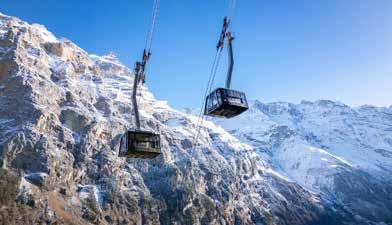
In December, Switzerland put its name in the record books with the world’s steepest aerial tramway built by Garaventa. The first section of the Schilthornbahn 20XX features a dizzying 775-metre climb and a 159.4% gradient over a distance of 1,194 metres. It connects the Swiss villages of Stechelberg and Mürren in the Bernese Highlands. The tramway also contains two other sections, i.e. between Mürren and Birg, and then between Birg and the summit of the Schilthorn at an altitude of close to 3,000 metres. The climb takes 22 minutes, and the ride is open all year round.

The prospect of a heated seat and protective bubbles can make a chairlift journey much more comfortable and appealing, especially when bonechilling temperatures and winds set in. They have already entered the mainstream in Austria, such as in Ischgl and Kitzbühel, but they are struggling to gain traction in France. The first example (the Vinouve chairlift manufactured by Doppelmayr) was installed in Les Karellis back in 2006, followed by Les Arcs in 2017. Méribel and Val d’Isère have also opted for heated seats, but the trend is still very much in the minority in France. There are various reasons to explain why heated seats have been given a cooler reception in France, such as the cost of the financial investment required and its repercussions on ski pass prices, as well as the environmental impact of having to use extra energy to actually heat the seats. To overcome this last issue, manufacturers advise that solar power and regenerative braking systems are available to produce energy.
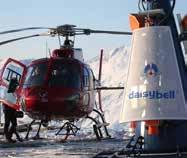
This helicopter-mounted gas system allows for the rapid treatment of numerous avalanche corridors and zones, depending on the assessed level of risk. ©MND
Since early January, the California Department of Transportation, the US agency responsible for the state’s highway system, has been testing the heli-portable DaisyBell™ avalanche prevention system pioneered by French group MND, the global leader in avalanche risk prevention and control. This solution will improve safety on the roads crossing the eastern slopes of the Sierra Nevada, in areas that have recently been threatened by avalanche risks. The Ministry of Emergency Situations of Kazakhstan has also been conducting field tests in the mountainous regions of eastern Kazakhstan, where some 619 avalanche-prone areas have been identified.
DaisyBell™ is a mobile helicopter-mounted avalanche triggering system based on the explosion of a hydrogen/oxygen gas mixture inside an open cone. The system brings precision, speed, mobility and total safety for users, whatever the weather conditions.
This is the number of ski resorts that China had in 2024, i.e. 22 more than in 2023. The country has now muscled its way to the top of the world leader board in terms of the number of ski resorts. Nevertheless, these figures should be put into perspective, since their size, altitude and number / type of ski lifts vary tremendously from the giant resorts in Europe and North America.
In collaboration with Poma, La Plagne inaugurated the world’s first two open cabins (called Aérolive) during the summer on the Les Glaciers gondola lift that climbs to the new Live 3000 summit at an altitude of 3,080 metres. The unique sensory experience is guaranteed to get passengers’ blood flowing and hearts pumping as the wind whistles through their hair. The overall experience takes 30 minutes, which includes a briefing and then the actual ride for six harnessed people attached to a lifeline, who can feast their eyes on the panoramic views over the landscape thanks to the cabins’ glass-less design and slatted floor. The POMA Group supports its customers in diversifying their business activities in every season through a broad array of innovative solutions aimed at every target market.
This groundbreaking design received an award at last year’s Mountain Planet show, following which Poma received several leads for other projects around the world.
Aérolive has caught the eye of other French and international resorts. ©JnJ photo/La Plagne
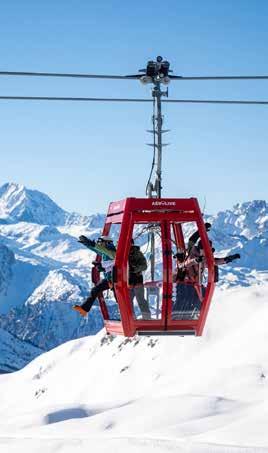
Early October, the non-glacial resorts of Levi and Ruka in Finland opened up their ski areas, even though there had not been any snow. For several years, they have been collecting snow at the end of the spring, putting it in storage and then bringing it out in the autumn according to the practice of snow farming. Two weeks are required to transform the tarpaulin-covered mounds of snow into skiable pistes using mats developed by Finnish company Snow Secure, which are made from extruded polystyrene, the same material used in home insulation and offering a service life of more than 20 years. The snow farming principle allows snow to be kept with very few losses, even when temperatures rise during the summer. In Ruka, when the mounds are uncovered in October, there is still about 80 to 90% of the snow left. Levi embraced the technique after it was forced to cancel the first slalom races in the Alpine Ski World Cup calendar on three occasions, which are held during the first or second week of November. Since it has started snow farming, it has not had to cancel a single race. Even though the principle comes at a price, the resort can count on a winter season lasting seven and a half months, which equates to a 15% increase in its net income. With snow farming, resorts can guarantee their opening dates, keep jobs safe, prevent the use of artificial snow, avoid being dependent on weather conditions and, in the case of low and mid-altitude resorts, potentially futureproof their business model. Since last year, Snow Secure has been exporting its solution to Norway, Switzerland, Spain and the United States.
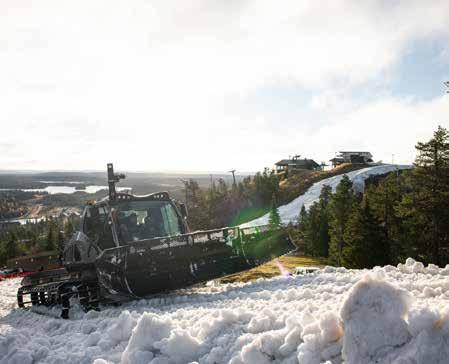
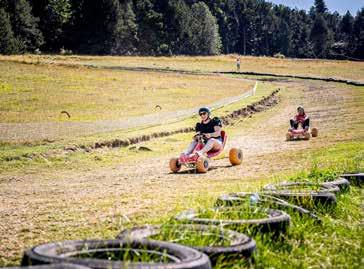
Over the past few years, the small resort of Mont Serein in southeastern France has been steadily shifting its focus towards summer leisure activities, but in the spring it decided to step its efforts up a gear as snowfall patterns started becoming too unpredictable. The local authority-owned public company that oversees the Mont Ventoux area has decided to make the best of the hand dealt by Mother Nature. Snow will always be a welcome sight, but a lack of snow will no longer be a deal-breaker. Investments will be directed into developing the resort’s summer activities and catering for the public’s need for fresh air, thrills and sensations. The resort has already put together an extensive range of activities, including a downhill go-kart trail, downhill tubing, tree-top courses, a bungee trampoline, a play area with inflatable structures, all-terrain electric scooters, paintball and a bike park.
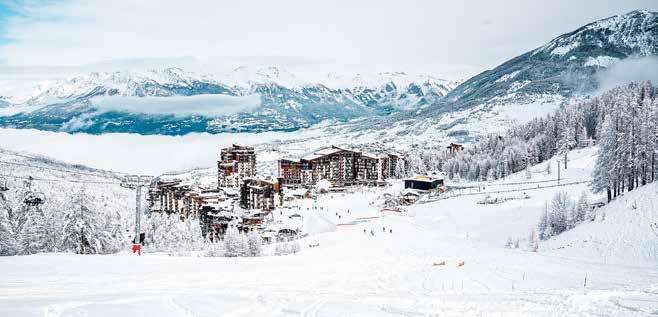
The Les Orres ski resort has applied to participate in Ritmo, which is a new programme under the European Alcotra 2025-2028 scheme (which aims to foster cross-border cooperation) alongside French and Italian partners in an effort to define an effective and innovative process for renovating tourist buildings that can be replicated across the Alps. “France’s Climate & Resilience Act has laid out a set of requirements for improving buildings’ energy performance and significantly reducing land take, meaning that the need to refurbish and upgrade existing properties is more essential than ever. But the process is anything but a walk in the park. There are many barriers that stand in the way, and each one has to be knocked down. There’s also a lot of different parties involved, whether property managing agents, co-ownership associations or property owners, and the situation is compounded further by the fact that some of the tourist accommodation in the Les Orres 1650 resort is located in buildings that are officially recognised as remarkable examples of contemporary architecture, so certain restrictions apply,” explains Pierre Vollaire, Mayor of Les Orres. The other aim behind the programme is to promote the local building renovation sector and enable firms to enhance their skills further by providing training, setting up certification schemes and creating a platform where they can share best practices, feedback and technological resources. Finally, the idea is to develop concerted strategies to remove the administrative and financial hurdles alongside the relevant authorities in the Provence-Alpes-Côte d’Azur and Piedmont regions.
The Hautes-Alpes resort is focusing its efforts on defining a replicable process for renovating tourist buildings
million
That is the amount that France’s ski areas invested in 2024.
New ski lifts came top of the investment list with €295 million.

• ⁃ Les Deux Alpes: €66.6 million (ex. VAT)
• Val Thorens - Orelle: €58.9 million (ex. VAT)
• Les Arcs - Peisey-Vallandry: €50.2 million (ex. VAT)
• Saint-Gervais - Saint-Nicolas: €45.2 million (ex. VAT)
• Val d’Isère: €26.6 million (ex. VAT)
• Tignes: €23.9 million (ex. VAT)
• Chamonix - Les Houches: €22.7 million (ex. VAT)
• Les Saisies: €15.7 million (ex. VAT)
• Gourette: €15.6 million (ex. VAT)
• Courchevel - Les Praz - La Tania: €15.5 million (ex. VAT)
Source: Montagne Leaders

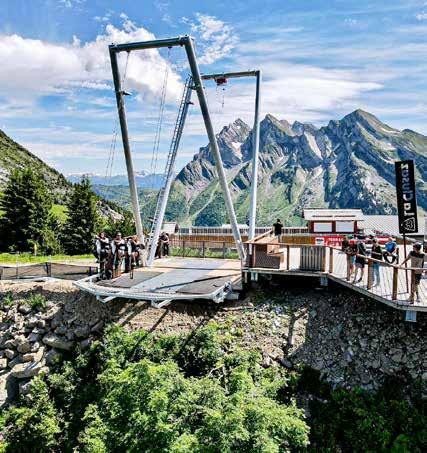
The Haute-Savoie resort of La Clusaz has clearly decided to head down the innovation path as it looks to diversify its range of services and activities. It has ploughed €450,000 into a giant swing (aptly named “La Bascule” or “The Swing”), which is perched on the terrace of the Balcon des Aravis at an altitude of 1,860 metres. The six-minute white-knuckle ride offers a choice of intensity levels for a truly customised experience, and thrill-seekers can even have the seat tilted to a 90-degree angle! The swing provides the ideal opportunity to admire the alpine landscape sprawling all the way from the Confins Valley to the Aravis mountains.

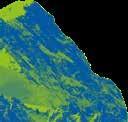
The resort is offering a new activity for the ultimate adrenaline rush.
©La Clusaz
«There are plenty of opportunities for using artificial intelligence, especially to improve our marketing strategies. AI will give us clearer insights into our customers, and we can then use that intel to fine-tune our solutions and provide the services offering the best fit for their needs. AI can also play a valuable role when looking to develop solutions for operating our tourist infrastructures and facilities more effectively or driving down our energy use.»
STEFAN SJÖSTRAND, President and CEO of Swedish group SkiStar AB, in the Cluster Montagne trend book
Demaclenko has installed a «Ghost» in Zermatt after introducing this innovative system back in 2023. With the «Ghost» system, a snow gun is mounted on a hydraulic lifting device and can be lowered fully into a pit through a hatch when it is not in use or during the summer. As such, the snow gun blends seamlessly into the surrounding environment, and not the slightest component can be seen on the surface. The structure is engineered to withstand the weight of a snow groomer, meaning that it can be installed in the middle of the pistes.
A snow gun is mounted on a hydraulic lifting device and can be lowered fully into a pit.
©Demaclenko

Chief Customer Officer at e-Liberty Services
AI-powered dynamic pricing
«Nobody has gone back»
E-LIBERTY SERVICES HAS INCORPORATED DYNAMIC PRICING INTO ITS SOLUTIONS. AROUND 15 SKI AREAS HAVE ALREADY SIGNED UP FOR THE SYSTEM.
How exactly does AI-powered dynamic pricing work?
We’ve developed an in-house algorithm that modifies prices in real time after analysing the sales history. We’ll take any unpredictable factors out of the equation, such as weather conditions and snow depth, so that only the foreseeable parameters are left (school holidays, changes in period, specific events, and so on). The aim behind the whole system is to determine the level of price sensitivity.
Will ski areas still be in control of determining their own prices?
The solution may be powered by AI, but it’s still controlled by humans. Ski areas can set the boundaries on what the AI system actually does. Some customers have already agreed on a minimum price with tour operators and works councils, so dynamic pricing shouldn’t go below that threshold. Other customers, like N’Py, have set up a loyalty scheme for their remote payment system, so we’ll make sure that day-based dynamic pricing doesn’t cannibalise their prices.
What are the applications?
We’ve identified five main applications:
1. Increase revenue streams by selling at the best price and at the best time.
2. Reduce ski areas’ dependence on weather conditions by encouraging skiers to purchase well in advance to take advantage of a given price.
3. Smooth out visitor levels, sometimes by applying dynamic pricing according to the time of day. Compagnie du MontBlanc uses this approach for the Aiguille du Midi or MontBlanc tramway, while N’Py does the same thing for the Pic du Midi.

4. Generate cash flow by incentivising end customers to buy in advance.
5. Simplify the process of selling and configuring products, since our solution is primarily designed to generate prices. This prevents ski areas from having to think about developing price scales or setting up one-time offers.
What feedback have you received? Is the solution boosting their revenue?
Over a full season last year, we saw that the revenue from the products sold with this system increased by an average of 15%, while the number of tickets sold rose by 20%. It’s an attractive prospect for a ski area that runs on fixed costs.
The solution has been working for four years now, and nobody has gone back. We’ve even decided to incorporate dynamic pricing into our legacy solutions. We didn’t build our company on dynamic pricing, bearing in mind that we’ve been in business for 20 years.
Compagnie du Mont-Blanc in Chamonix is our main customer when it comes to volume, and they’re also the first ones who called on our services. Around 15 other customers have since followed suit, including La Clusaz, Pra-Loup, Saint-Gervais, Megève, Orcières, Les 7 Laux, Villard-de-Lans and Le Collet d’Allevard. We’re expecting to see between five and ten new customers come on board next year.
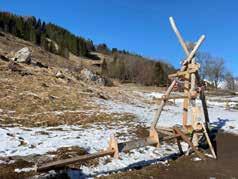
Roule ma Boule designs gravitybased wooden ball runs for outdoor use.
©Frédéric Caul-Futy
This year, Cluster Montagne Labs is delivering its support and guidance to seven projects, which will be tested out in the field. The Alpvengers platform is designed to provide local authorities and companies with the opportunity of creating bespoke temporary events with the focus on sustainable and virtuous practices. Ingélo, the engineering subsidiary of Compagnie des Alpes, has developed a system for moving the water contained in hillside dams to ensure interaction with the air and thereby improve cooling and increase snow production performance, while cutting energy use by 90%.
Intence is rolling out its innovative XP Connect facial recognition technology for matching skiers with their ski pass. The system was launched in Bagnères-de-Luchon during the winter. The Resalocal platform centralises all the data for a specific destinationin real time to provide visitors with a wealth of information about the resort and the services and activities on offer. Roule ma Boule designs, develops and manufactures bespoke outdoor wooden ball runs, featuring routes and play elements installed along a sloping surface, such as this forest ball run in Corrençon-en-Vercors. Sentmi is a research project led by a consortium comprising Léon Grosse, Brochier Technologies, Inouid and LOCIE, and involves an optical fibre-based 2D surface sensor that is affixed to a fissure in an engineered structure. The connected patch provides an overview of the infrastructure’s condition and sends an alert to the facility’s manager in the event of an incident. XtrmUs has developed the X-Community platform for skiing competition organisers and skiers. The platform allows users to track an athlete’s journey and position in real time.
The Smart Ski Experience project led by a consortium comprising Rossignol, Lumiplan and the CEA research organisation in Grenoble is designed to provide skiers with feedback on their technique and performance by fitting a sensor to their skis, which communicates with their smartphone by Bluetooth. This means that skiers can up their game, push their boundaries and see how they compare to others. The first large-scale trials were conducted during the World Alpine Ski Championships in 2023. The trials have provided Rossignol with invaluable insights into how its products perform and their level of wear. The project has also enabled Lumiplan to improve its algorithms, at a time when its customers are looking to gain a clearer understanding of the different types of skiers and their habits. All that remains is to come up with a business model.
In January 2023, a new breed of ski resort opened its doors in Italy, namely a ski area without a ski lift. The Homeland resort near Montespluga in the north of the Lombardy region offers 11 off-piste trails sprawling across a 36 sq. km backcountry area that skiers can climb and descend on their own or with an alpine guide. This new concept has been developed to offer a more sustainable alternative and anticipates the end of the all-alpine skiing model. In all honesty, this is the not the first time that a liftless resort has been trialled. Homeland actually draws its inspiration from Bluebird Backcountry in Colorado, which was based exclusively on ski touring... but which ultimately closed after failing to reach profitability. Could it be heading down the right path this time?
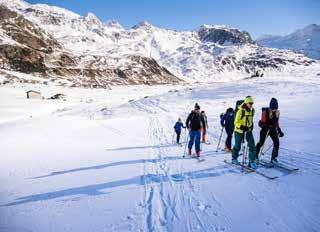
After Bluebird Backcountry (Colorado), which was a commercial failure, it’s in Italy, with Homeland, that the concept of lift-free resorts is trying to make inroads.
©Homeland
In 2022, all the ski areas across the N’PY network accurately recorded the greenhouse gas (GHG) emissions from their activities. Following their carbon footprint assessment, Compagnie des Pyrénées was chosen alongside nine other national companies specialising in the tourism industry to take part in the experimental design for the ACT methodology (Assessing low Carbon Transition) spearheaded by France’s environment & energy management agency (ADEME).
With support from Lyon-based consultancy firm BL Evolution between April 2023 and the autumn of 2024, Compagnie des Pyrénées looked into the prospect of building a decarbonisation strategy and generally a plan for migrating its activities, which involved all the ski resort directors and QSE officers, as well as the board of directors.
All the stakeholders worked together in developing a short, medium and long-term action plan. «It showed that we were already taking steps to bring down our energy use, reduce our waste and save water,» explains Arnaud Cercos, Head of Technical and Environmental Development at Compagnie des Pyrénées / N’PY. Prime examples include the purchase of green energy from local hydropower plants, a fleet of snow groomers running exclusively on HVO in Peyragudes, and the decision to replace all diesel-powered buses with electric vehicles to cover the last mile in Peyragudes. A few more initiatives are required to achieve net zero in the resorts, such as recycling old ski lifts and snow groomers, and promoting
short supply chains for food service providers. Ultimately, only 8% of the total impact of the greenhouse gases in the resorts can actually be attributed to the ski areas. Transport is still the main culprit. Therefore, the solution for decarbonising transport to the resorts lies with the region’s authorities.
«Taking the train or guiding public transport convoys to the resorts could be one of the answers,» advises Arnaud Cercos. But tourists still need to be convinced to change their transport habits. «We need to get all the different parties to step up and engage with the process. Ski areas have already achieved real progress in lowering their GHG emissions, but there are many other actions that will take time, because they rely on society,» admits Arnaud Cercos.
In addition to merely assessing the resorts’ carbon footprint, the various stakeholders have been considering a strategy of portraying the mountains as «a way of life and not just a consumer destination» and encouraging people to think about embracing the transition. «How can we attract people to the mountains outside the winter season and how can we maintain a comfortable level of business when there’s no snow?” asks Arnaud Cercos. Every investment now needs to be considered from a different angle while prioritising activities that are capable of generating revenue all year round. Next year, Grand Tourmalet will replace a chairlift with a cable car, which is not only more inclusive, but offers greater functionality whatever the season.
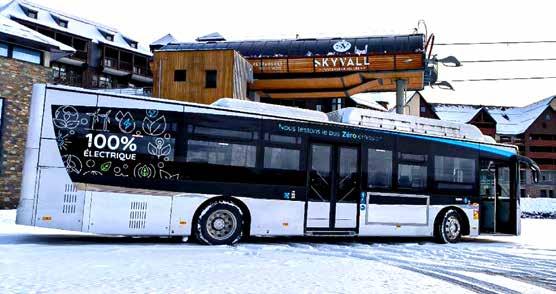
Peyragudes has swapped its diesel-powered buses for electric vehicles.
MOUNTAIN PLANET



INTERNATIONAL MOUNTAIN PLANET / ANALYSIS
Facts, figures, visitor levels, trends, snow cover… in his international report on snow & mountain tourism 2023/2024, Swiss consultant Laurent Vanat scrutinises 68 countries in exacting detail. With some 366 million skier days around the world, Laurent Vanat describes the previous season as «business as usual - season 2» in reference to the punchline of his 2022/2023 report. Insights to follow...
BACKGROUND
THE 17TH EDITION OF THE INTERNATIONAL REPORT ON SNOW & MOUNTAIN TOURISM COVERS:
68 countries
5,898 ski resorts of every size, including.
• 1,803 resorts with more than four ski lifts,
• 730 stations with more than 100,000 skier days during the season.
SNOW & WEATHER CONDITIONS 2023/2024
(vs the previous season)
↑ Excellent snow conditions in Chile and Argentina: record-breaking visitor levels,
↓ Warm weather conditions across Eastern Europe, Russia and Australia,
↓Poorer snow cover in the USA, Snow cover and sunshine continue to have the greatest influence on visitor numbers, but not all countries fall into the same boat.
THE FIGURE
366 million skier days around the world for the 2023/2024 season.
• Visitor levels down 1.3% on last year, but still within the average for the last 25 years,
• No significant downward trend.
TOP 5 IN THE GLOBAL RANKINGS (according to the number of skier days)





Positive news for China, while Italy confirms its upward momentum
(2023/2024 season compared to the average of the five pre-Covid years, according to the number of skier days).
China
USA
Italy
Russia
Sweden
Norway
Finland
Switzerland
+5.9 million skier days
+5.7 million
+4.2 million
+1.7 million
+1.2 million
+0.7 million
+0.4 million
+0.4 million
GEOPOLITICAL CONTEXT
Nationalism on the rise
The geopolitical situation is influencing trends in the global snow and mountain tourism industry: China: an appealing market for exports, as China starts manufacturing its own ski lifts, Russia: the country will ramp up efforts to drive its own development.
OF THE GLOBAL SECTOR slow progress
After the progress achieved by US group Vail Resort and French company Compagnie des Alpes, the trend towards global consolidation among ski resort operators is slowing down.
+13 à 19%
The last two years have been witness to a 13 to 19% increase in ski pass prices in the main ski resorts in the USA, China, Italy, France, Austria and Switzerland.
This rise is higher than what has previously been seen and can be explained by spiralling energy costs.
GROWING FINANCIAL PRESSURE ON THE MIDDLE CLASSES
The decision by governments to invest greater resources into their foreign policies instead of their domestic policies is putting Europe’s middle classes under increasing financial strain, which in turn is affecting the health of the domestic snow and mountain tourism markets.
A closer look at three new ski resorts that have recently cropped up where they were least expected:
• Russia: Manzherok - a beautiful ski area whose design reflects best practices
• Armenia: Myler - a station under development with clearly stated ambitions
• Czech Republic: Orlické Záhořík - a tiny family-run resort that aims to bring skiing to a wider public
• Austria and France: visitor levels have not shown any real signs of falling. Even though performance in recent years has been somewhat below par, the finger of blame cannot be pointed at climate change.
• taly: the last two seasons have been the best ever.
• Switzerland: visitor levels have tapered off, but climate change is only part of the cause:
• 5% of the fall can be explained by resort closures,
• 39% of the fall is associated with the fewer number of days that resorts were open during the season,
• 56% of the fall can be attributed to the lower number of skiers during a normal day’s skiing (several reasons, such as the price of passes and the impact of exchange rates for foreign skiers, etc.).
(for the time being)
Booking all the components of a skiing holiday (transport, shuttle, accommodation, ski pass, skiing lessons, etc.) on the resorts’ online platforms is still an uphill struggle and sometimes an insurmountable obstacle. Compounded by a lack of integration into official websites, inflexible tour operators and only a handful of API solutions, digital technology is still falling short when it comes to the initial stages of the customer journey.
The number of American skiers flocking to European and Japanese ski resorts during the 2022/2023 and 2023/2024 seasons reached recordbreaking levels.



A hike in skiing prices in the USA with passes sometimes hovering near the $300 mark and the growing level of dissatisfaction with the ski resorts at home are driving up the number of American skiers heading over to the ski areas in Europe and Japan.
«Business as usual - season 2» is clearly the keyword. Performance over the previous season continues to show that the industry is in fine form, while painting a positive picture for the potential of the skiing industry in the years ahead. The mountain tourism sector still has a number of cards up its sleeve that it can play. If any evidence were needed, global visitor levels widely fall within the average numbers seen over the last two decades. Alpine countries have maintained their position on the international stage, with performance constantly rising in Italy over the last two years and a growing number of American skiers abandoning their home resorts in favour of Europe (a significant development, but with little impact on the figures). Now unshackled from the long-lasting effects of the Covid pandemic, China achieved the greatest progress last season, not only in the international arena but also in the country’s history.
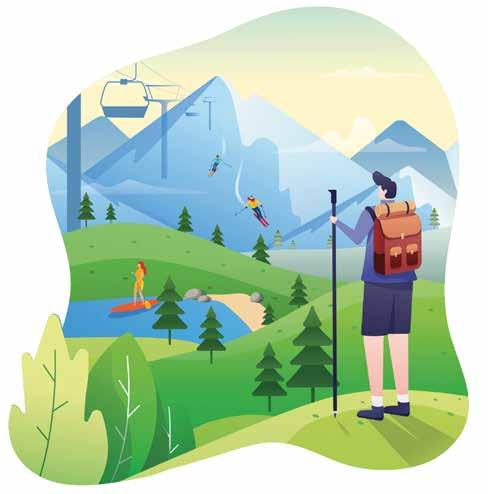
Widely considered a very promising country for growth in the mountain development market, could China become a key industry player?
In 2000, there were almost no ski areas in China. From 2013 to 2020, the number of skier-days more than doubled, boosted by the prospect of the Beijing Winter Olympics. Although hindered by the Covid pandemic, the country has real potential to become a major ski nation. Focus on the Middle Kingdom.
Following the euphoria of the Olympic Games, subsequently cooled by the pandemic and its repeated returns, as well as the contraction of the global economy, China’s ski industry showed a slight slowdown in 2023, with a 7.9% drop in the number of skier-days*. Where mountain businesses had dreamed of a commercial Eldorado, spurred on by state predictions targeting 300 M skiers in 2030, the reality has been more mixed. Mixed results in a country with a billion inhabitants, capable of going from almost zero to over 700 ski resorts in less than 25 years, is nonetheless impressive. “I’ve been in contact with China since 2015, just before it was officially awarded the 2022 Olympic Games. The country was keen to find out more about the ski industry. As soon as it was awarded the Olympics, we saw a huge buzz around skiing develop and massive, nationwide momentum. Every industry worked together. I’ve never seen that before,” explained Laurent Vanat, an industry specialist and author of an annual report on mountain and snow tourism, when speaking to the Swiss media a few months ago.
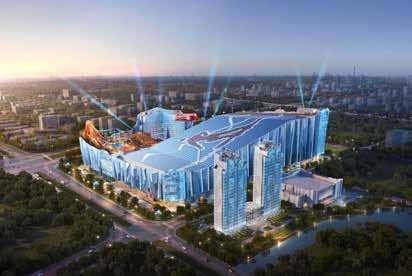
Although China is not historically a ski nation, two-thirds of the territory is covered by mountains, with temperatures that frequently reach as low as -10° and -20° in the north. Where other countries lack a cold-climate culture, China’s is well-established and stands alongside a climatology that favours natural snow production. With a fast-growing middle class and 80% of beginner skiers offering excellent prospects for activities and equipment, the country boasts a significant customer base. Above all, the ambition to establish itself on the world stage for mountain development reflects real political purpose. On 06 November 2024, the State Council of China announced an objective to invest 169 billion dollars in the ice and snow economy in 2027 and 208 billion dollars between now and 2030, representing annual growth of approximately 7.5%. Measures include the prioritisation of integrating winter sports into school physical education programmes in order to train a new generation of skiers.

In the highly awaited 2023/2024 white paper on the Chinese ski industry, expert Benny Wu pointed to a recovering economy, with a total of 719 winter sports resorts, 16% more skier-days in the year, and significant development of indoor winter sports centres. Of course, it is important to consider the configuration of Chinese resorts in these analyses. Many are equipped only with carpet lifts, 33 (out of 719) are above 300 m, and only 16 have more than 4 ski lifts. Nonetheless, China stands out as an all-category champion of indoor skiing, with 60 indoor resorts. In Shanghai last September, the country opened the L+Snow Indoor Skiing Theme Resort, a conglomeration spanning almost 100,000 m², with four ski slopes, including the largest indoor slope in the world, as well as gondola lifts and chairlifts, a shopping centre, hotels and restaurants, and a 20,000 m² water park on the roof (due to open in 2025).
A ski resort in Jilin Province, which aims to attract 230 million winter tourists and generate 57.7 billion dollars in revenue by 2027-2028.
This impressive annual progress is combined with a ski and non-ski strategy that vastly appeals to the Chinese public. “In China, there are fewer ‘pure’ skiers. A large part of the population visits resorts to discover the wide range of ice and snow activities. On the frozen lake of the Wanda-Changbaishan resort, there are, for example, more than 50 different leisure activities available,” explained Cluster Montagne Director Benoit Robert, speaking to La Tribune AURA. There is also much to experiment with in terms of new models of customer journeys and the diversification of non-skier tourism options.
The Chinese Ministry of Culture and Tourism recently released new national itineraries for ice and snow tourism for the 2024-2025 season, encouraging the industry’s growth. Its report estimated that there would be 520 million consumers of ice/snow activities in 2025 (21%+), generating over 86 billion dollars in revenue.
KEY FIGURES FOR THE 2023/2024 CHINESE SKI MARKET*
• New resorts: 30+ opened (15 indoor and 15 outdoor).
• Total number of resorts: 719, up 22 from the previous year.
• Resorts with aerial ropeways (cable cars, gondola lifts, chairlifts): 176, up by 10 versus 2022/2023
• Skier days: 23.08 million, an increase of 16.3%
• Individual skiers: 12.8 million
• Number of days skied per person: 1.8 days, versus 1.77 the previous year
• Indoor resorts: 60, 20% more than in 2022/2023. These indoor resorts attracted 4.88 million visits— an increase of 33.7% thanks to their accessibility and modern equipment.
• Ski lifts: 30+ new aerial ropeways (gondola lifts, cable cars, chairlifts).
• Visits to resorts > 300 m: 51.07%+
In parallel, South China, which is known for its moderate temperatures, has also boosted its skier numbers, notably thanks to its indoor centres, which offer the perfect training ground for complete newcomers.
At the end of 2024, 50% of the ten most popular ice/snow destinations in China were located in the south of the country. In the north, the Jilin province alone aims to attract 230 million winter tourists and generate 57.7 billion dollars in revenue by 2027-2028.
The objective? To become a world-class centre for winter tourism thanks to the creation of two new ski resorts and the year-round operation of 100 snow parks. From state investments to public popularity and the increased power of the ice and snow industry, both indoors and outdoors, China is making great strides. “China will continue to rise in the world rankings,” estimated expert Laurent Vanat in an interview with Swiss media in late 2024.
* Source: 2023/2024 China Ski Industry White Book
Expanding and acquiring ski areas is clearly an integral part of the strategy pursued by Vail Resorts and its direct rival, Alterra Mountain Company. After snapping up Andermatt and Crans Montana, the group is training its sights on other alpine targets. Read on for an analysis of a powerful acquisition strategy that is starting to change the economic landscape of Europe’s winter sports sector.
The arrival of these US giants has definitely set tongues wagging in Switzerland. Some see their presence as an opportunity for modernisation, while others are worried about the effect on Switzerland’s heritage.
Vail Resorts and Alterra Mountain Company, the top two US ski resort operators, have already carved up a commanding share of the largest ski areas in the United States, and now they are competing to add even more destinations to their portfolios. After spending several years growing their business in the domestic market and surrounding areas, Europe is now firmly on their radar. Harbouring the most attractive resorts in the world and boasting a market that is twice the size of the US market, mainland Europe certainly comes across as an enticing prospect. Vail Resorts set the ball rolling in 2022 by acquiring Andermatt-Sedrun, followed by Crans Montana in 2024. But its thirst for expansion remains unquenched, and its rival Alterra could well venture down the same path.

Vail Resorts recently hit the headlines in the Swiss media when rumours began to spread that it was planning to buy the resort in Verbier. According to the Zurich-based daily newspaper Blick, the US giant has got its eye on five or six ski areas in Switzerland and Austria, and top of its list are Weisse Arena in the canton of the Grisons and the Flims-Laax-Falera ski lift company. «We will not comment on the rumours or speculation about our potential acquisitions in Europe. Our acquisition process is strategic and carefully planned. We do not collect resorts. We are focused on investing in our existing destinations and enhancing the customer experience closely alongside the people on the ground,» explained John Plack, Director of Communications for Vail Resorts. Sometimes labelled the «Evil Empire» by the skiing community, the company denies claims that it has an excessive appetite. «We are constantly investing for our customers, to preserve natural resources and improve living conditions in the areas where our company operates. In Crans Montana, we have lined up an investment package of more than 30 million Swiss francs, including plans to buy 40 new snow groomers
and reopen the Plaine Morte restaurant,» adds John Plack. According to a report in Swiss-German newspaper «NZZ am Sonntag», Alterra is also scoping the market for potential destinations or hotel projects. Alterra has apparently already approached one major ski resort, but its overtures came to no avail. Vail Resorts’ privately-owned rival is extremely discreet and does not wish to divulge its strategy. Whatever the case, it clearly has no intention of being intimidated by its competitor. Alterra is also active in Europe. For the time being, the company is scouting for partner resorts and is tending to prioritise a policy of forging prestigious alliances instead of acquisitions.
Vail’s Epic Pass and Alterra’s Ikon Pass are annual subscriptions that are sold at the end of the season for the following winter. Unlike the Magic Pass (created in Switzerland by Magic Mountains Cooperation) for Swiss resorts, these passes grant access to renowned ski areas around the world. Both companies are engaged in a closely fought contest in Europe, with Alterra Mountain Company’s pass covering Chamonix, Zermatt, St-Moritz, Kitzbühel and Skirama Dolomiti, and Vail Resorts’ pass encompassing Les 3 Vallées, Verbier, Crans Montana, Arlberg and Dolomiti Superski. These «super-passes» offer unlimited access to the resorts owned by the groups and limited access of a few days to their partners’ destinations, who receive what is said to be significant compensation for each day of skiing. «We have or previously had business agreements with both groups for some of our destinations. These ad hoc agreements are negotiated with the resorts and based on what the local teams consider to be fair,» explains David Ponson, Mountain Division and Outdoor Activities Director for Compagnie des Alpes.
42 destinations (USA, Canada, Australia and Switzerland)
Annual subscription: EPIC PASS (over 80 destinations)
Price: approximately $1,000
• Unlimited access to the group’s 42 resorts
• Limited access to partner resorts in America, Australia, Europe and Japan
«I don’t know whether that business model could be replicated here. In any case, the strategy at Compagnie des Alpes is focused exclusively on Europe. These mega passes force groups to engage in a game of one-upmanship as they try to offer their customers ever more destinations. Their acquisitions are aimed more at enriching their passes than expanding into new areas. Overall, they invest relatively little money in the assets and facilities at their ski areas.» The arrival of these US giants has definitely set tongues wagging in Switzerland. Some see their presence as an opportunity for modernisation, while others are worried about the effect on Switzerland’s heritage. Looking further ahead, it is only a matter of time before most of the major resorts in Europe are faced with a choice between the Epic Pass and the Ikon Pass, even if it is just a cooperative arrangement. The situation is less clear-cut when it comes to acquisitions, since ski lift management models in Europe are different and sometimes shrouded in complexity, which makes for difficult negotiations. This year, Vail Resorts’ name was all over the news when its ski patrollers walked out on strike, which made a significant dent in its image.
Late Apex Partners, one of its largest shareholders, published a letter in which it called for the CEO to be ousted and advised the company to concentrate on its partnerships instead of capital-intensive acquisitions. Maybe the US invasion is not on the agenda just yet.
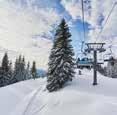

19 destinations (USA and Canada)
Annual subscription: IKON PASS (over 60 destinations)
Price: approximately $1,300
• Unlimited access to the group’s 19 resorts
• Limited access to partner resorts in America, Europe, Australia and New Zealand, Japan and Chile
While French resorts continued to invest in 2024, in particular to support the development of year-round mountain tourism, key players in mountain infrastructure have been just as attentive to opportunities arising further afield. While geopolitical and climate-related factors have reshaped the landscape in some parts of the world, new markets are emerging. These include supplying equipment for new ski resorts, developing four-season tourism and building urban and recreational ropeways, sometimes in unexpected destinations. Here is a global overview of these “emerging” countries and a look at some of the major industry projects.
Laurent Vanat, an international expert on the ski resort economy, has just published his report on the state of the ski industry worldwide. “The market isn’t dead, but there are fewer new resorts or they are based in China, where equipment is now manufactured locally, and in Russia, where western suppliers have been excluded.” Consequently, in the emerging countries,

investment is increasingly focused on urban and tourism-related projects in preparation for the future.
Political and climate changes have highlighted the agility of companies operating in the mountain development sector.
“With the unprecedented Covid crisis, followed by local elections, investments were put on hold.
But in 2024-25, we are seeing a strong recovery across all projects. But the French market is extremely mature,” says Mehdi Caillis, Director of Public Affairs and Urban Transport at MND. “As part of our new strategic plan, we’re changing our focus towards urban development, in France, but also for export.” Currently, exports account for 65% of MND’s business, while at POMA, one-third of its turnover comes from urban transport projects.
At Doppelmayr, urban and tourism ropeway projects represent on average 40% of revenue.
“Ropeway transportation follows quite a cyclical trend. There were projects in South America, then Asia, mainly in China and South Korea, but currently there are fewer such projects in this region,” notes Mehdi Caillis. The market has slowed after some striking facilities were created in Asia, including cabins serving the Great Wall of China and
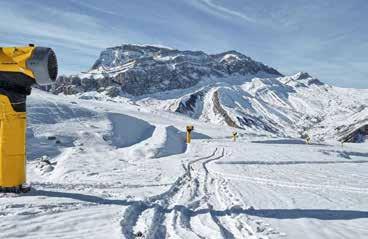
Doppelmayr’s longest (8 km) tricable gondola ropeway in Hon Thom in Vietnam.
• After a ropeway in Simatai near the Great Wall of China and gondolas linking sacred sites in Korea, POMA is now set to deliver an urban cable transport system designed to connect several districts in the city of Ulaanbaatar in Mongolia. The project includes 122 cabins covering a total distance of 6 km. An investment of between 30 and 150 million euros for a silent, fully-electric system.
Laurent Vanat explains: “In this region, we occasionally hear of new projects, for example, when Kazakhstan was a candidate to host the Olympic Games, but they rarely get off the ground. However, one notable development is the new resort in Armenia, Myler, the country’s third resort.” The Austrian company SUNKID, a global leader in four-season leisure equipment installed the magic carpets for the beginner areas at this resort. “In Central Asia, they have some major projects, but the local population does not generally take part in skiing,” the expert continues, pointing out the wonderful Shahdag resort in Azerbaijan, which has state-of-the-art facilities, but very low visitor numbers.
• “Central Asia shows exciting potential, with some noteworthy projects. However, these are often driven by a targeted tourism development strategy focused on a single site and not necessarily as part of a broader national development strategy for winter sports,” explains Max ROUGEAUX, Marketing Manager at Technoalpin, which supplied the snow making systems for the Shahdag resort. A large-scale operation with 130 snow guns, 8.5 kilometres of line material and a machine room housing 14 pumps, all delivered in just 6 months. This was an exceptional achievement, especially in 2021, when travel restrictions and supply chain disruptions were causing major challenges for companies.
Across the Caspian sea, in Uzbekistan, the Amirsoy ski area, one of the country’s largest and most modern, was also equipped by Technoalpin. It is the first resort in the country to install a snow making system.
• Uzbekistan currently represents the largest market for MND with a 100 million euro contract for the Chimgan resort. The project is co-financed by an intergovernmental loan from the French government supervised by the OECD, and includes a 10-seater detachable gondola lift, an 80-seater aerial tramway, 2 chairlifts, 6 conveyor belts and a fully automatic snowmaking system. “The authority’s aim is to make Chimgan a holiday destination for the entire Uzbek population and, more broadly, for Central Asia as a whole,” comments Mehdi Caillis.
The Kyrgyz government has partnered with the Société des 3 Vallées (S3V) to develop a new resort, “3 Sommets”, which could become a flagship destination in Central Asia, thanks to its exceptional setting with reliable snowfall and abundant water resources. The resort will be developed in phases with the opening scheduled for December 2026. Eventually, the project will feature over 350 km of slopes and welcome over 800,000 tourists in both winter and summer.
• SUNKID has installed a next-generation, four-season toboggan run, Mountain Coaster 2.0 in Kazakhstan. The Austrian company is currently working on over 9,000 projects worldwide. “We’re seeing a significant global expansion of summer leisure facilities in mountain destinations,” comments CEO Emanuel Wohlfarter. “The best example is our magic carpet: 29 years ago, it was designed solely for skiers but it is now used in bike parks, toboggan runs, water parks and more.”
In Kazakhstan, SUNKID has installed a new-generation 4-season toboggan run, Mountain Coaster 2.0.

Across this continent, industry stakeholders are interested in the potential for ropeway transportation projects . “Everyone is focusing on this continent. Today, most projects are concentrated in North Africa, but other countries are beginning to show an interest in ropeways, including Rwanda, Côte d’Ivoire and Sénégal. Things are starting to move, but timelines tend to be long,” points out Mehdi Caillis at MND. “The major challenge when it comes to urban transport is the state’s ability to finance such projects, especially since, like all forms of public transport, the economic model does not allow the infrastructure to pay for itself.”
• POMA is working on developing a future cable car system for the capital of Madagascar. This first cable car line, an essential link in Antananarivo’s urban transportation system, will serve 7 stations spread over 8.7 km between Antsako, Anosy and Ambatobe, with an initial carrying capacity of up to 40,000 passengers per day.
• Tourism development projects are also emerging across Africa, for example the gondola lift at DianaLand, an amusement park in Agadir, installed in 2023 by the Austrian company Doppelmayr. This is a first in Morocco, taking visitors on a 6-minute journey at an altitude of 1,600 metres, during which they can enjoy breathtaking views over the Atlantic ocean, the port and the old town.
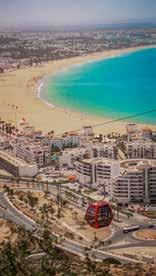
In this part of the world, the island of Réunion is particularly active in developing ropeway transportation, primarily to improve mobility, but also as a tourist attraction. The President of Cinor (Intercommunal Council of Northern Réunion), Maurice Gironcel, is keen to continue expanding these new modes of transport.
“Today, we no longer talk of mobility in the singular, but mobilities,” he told the Imaz Press agency, expressing his pride that the island is ahead of the curve in this area.
Following the success of Papang, the first urban cable car in the Indian Ocean, built by POMA in 2022 and which has carried over 4.6 million passengers in 3 years, Cinor has announced the laying of the first stone of a second cable line between La Montagne and Bellepierre this year, with delivery scheduled for 2028. At the time of writing, the contract for this second project had not yet been awarded.

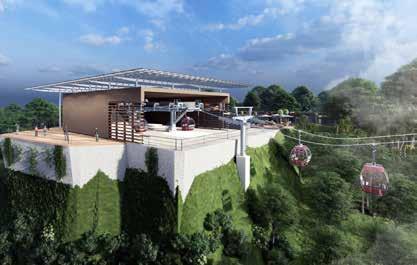
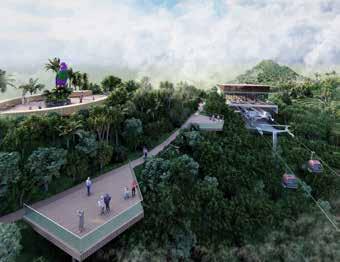
“In the ski resorts, Chile and Argentina experienced a good season in 2024. But there are few opportunities in these countries as investments are rare,” comments Laurent Vanat.
In terms of urban cable transport, the continent is a pioneer in this area. “Projects originated here, largely for topographical reasons. As early as 2004, installations began appearing in Medellin and today, there are 3 or 4 tenders a year in Colombia. In Bolivia, there are currently 10 lines with 2 more planned for 2025. Another giant, Mexico, is rearing its head with 5 projects already completed and many others on the horizon,” continues Mehdi Caillis.
• Following the first urban cable car in the Caribbean at Santo Domingo, a fully-horizontal line passing over the Ozama river, then a second, 4.2-km line in the north-west of the capital which opened in May 2023, the Dominican Republic has once again turned to POMA for a cable car project. Construction began in Autumn 2021, this time in Santiago de los Caballeros, to support the urban development of the country’s second-largest city.
• On the tourism market, Doppelmayr is building the world’s longest gondola lift on the island nation of Dominica, at the Boiling Lake site. At 6.6 kilometres long, it will transport visitors to the world’s second largest hot spring in just a few minutes.
In this region, Saudi Arabia is expected to see a surge in both urban and tourist projects, as the country looks to diversify its economy.
NEOM, the monumental project set in the middle of the desert and its Trojena ski resort slated to host the Asian Winter Games in 2029 has sparked plenty of controversy. Yet, despite being scaled back, it is undeniably taking shape.
It is already possible to ski beneath domes in this country, but this futuristic resort, built with a sustainable approach will be an open-air resort. It will use a system of snow makers powered by a lake overlooking the resort, a vast seawater reservoir with 3 dams, the largest of which is expected to be 475 meters wide and 145 high. After desalination, the water will feed the resort’s snow guns.
The Indian government is turning to urban cable car systems to resolve pollution and traffic problems. Under the Parvatmala scheme, a national ropeway development programme, the government has announced plans to develop over 250 projects within the next five years. The initiative promotes a “Made in India” ethos, although several projects may still be awarded to European companies. POMA, which is already operating in the country and has delivered two ropeway projects, has long believed in India’s market potential.
€568 million is the total amount that France’s ski areas invested in 2024. This figure was established by the annual survey conducted by the Montagne Leaders* magazine in partnership with Atout France and Domaines Skiables de France, and reveals a slight increase compared to the previous year. However, this number should be examined while factoring in the level of inflation that continues to hit prices and the major new programmes aimed at upgrading the country’s ski lifts. THE FIGURE
Number one cost item across the country.
52% of annual investments specifically for ski lifts.
EXAMPLES OF THE MAJOR NEW PROGRAMMES
• Construction work completed on the Jandri 3S cable car in Les Deux Alpes: one of the world’s largest cable transport investments = €50m in 2024 + €100m in 2023
• Cable cars in Les Arcs, Val-d’Isère, Val Thorens, Valloire and Saint-Gervais (L’Alpin & Le Valléen) = €145m
• Several buildings constructed to enhance the customer experience and improve the range of services on offer (Avoriaz, Chamonix, La Féclaz, La Plagne and Val Thorens) = €71m
€568m
in investments for France’s ski areas in 2024
+63% compared to the 10-year average
+4% compared to the investments in 2023 (€546m)
+49.5% compared to the investments in 2022 (€380m)

Effects of inflated prices over 10 years:
• Cost of the linear metre multiplied by 2.8
• Cost per elevation gain multiplied by 3.1
• Cost per passenger capacity multiplied by 2.2
• 36 new magic carpets to revamp the learning areas: threefold increase compared to the 10-year average.
• In response to the ever growing number of learners.
BREAKDOWN IN INVESTMENTS BY MOUNTAIN RANGE
• €279.4m in Savoie
• €115.2m in Haute-Savoie
• €88m in Isère
• €44m in the Southern Alps
• €37.8m in the Pyrenees
• €1.9m in the Vosges
• €1.3m in the Jura
• €1.3m in the Massif Central
ANNE MARTY

President of Domaines Skiables de France
«The investment figures for 2024 paint a clear picture of the efforts that operators and elected officials have been making every day to maintain and upgrade the range of services available across our resorts. What other sector of the tourism industry reinvests 34% of its revenue like France’s ski area operators in 2024? This wise choice to reinvest their revenue is also based on the Climsnow® studies that simulate the level of snow cover in 2050 and 2080. They can use this intel to guide their investments and adapt to the world of tomorrow.»
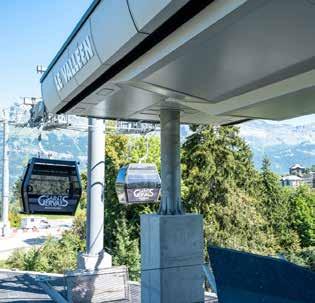
34% is the percentage of pre-tax revenue reinvested by French operators up 9 points compared to the 10-year average
Reflecting the determination to offer more services and experiences for snow and non-snow-related activities
CUSTOMER TYPES: increasingly young!
Mountain customers 18-24 years + 4 points 25 –34 years + 9 points
Closer look at the investments in leisure equipment: €13m
This
*All the figures in this 2024 investment review for France’s ski areas are based on the high-quality work performed by Montagne Leaders. All the survey results can be found in issue 306 of the magazine that was published on 24 February 2025, which is available by subscription or from the www.montagneleaders.fr website.








Conception et optimisation des installations, pilotage de la production




Work on the Lyon-Turin railway line was given the green light back in 2015, and by the time the project is completed in 2033, thousands of people will have been involved in digging the 57.5 km tunnel between France and Italy. But this gargantuan project will achieve much more than simply linking the high-speed rail networks in both countries, since it is already helping shape the future of the Maurienne Valley and its 45,000 inhabitants, without forgetting the surrounding mountain resorts.
The French State has actioned an exceptional initiative, known as the «Grand Chantier», to support the project and drive development across the Maurienne Valley area. As a prime example, Saint-Jean-de-Maurienne is treating the local area to a major facelift by installing new facilities and infrastructures, giving the town centre a makeover, and developing the international train station in a completely revamped district. The local hospital is also undergoing a major fit-out, while contractors are building a brand new emergency services centre. Not everything is being subsidised by the fund that has been specially created to support and foster development across the area in line with the Lyon-Turin project, but the driving force fuelled by political and local ambitions is leading the valley into a positive spiral. «Our employment gauges are full, and we’re still looking for lots of people. What with all the employees working at the tunnel and our companies looking to recruit more employees, the project has had a tremendous effect,» explains Philippe Rollet, Mayor of Saint-Jean-de-Maurienne.
«We’ve deliberately chosen not to set up dedicated living facilities for the worksite’s employees. This strategy has paid dividends, since lots of properties have been sold or renovated. Our public office for development and construction has accomplished a great deal with the TELT* in refurbishing a number of homes, and another landlord is planning to renovate 240 old workers’ housing units this year. These efforts to accommodate the Lyon-Turin project’s employees will leave us with a major portfolio of high-quality housing after the tunnel has been built,» adds Philippe Rollet.

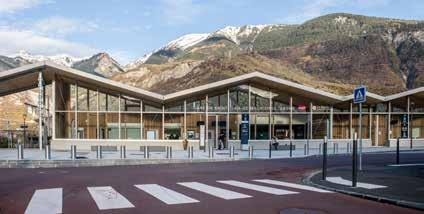
The tunnel will transform Saint-Jean-de-Maurienne into a central hub for all forms of transport across the Savoie area, while helping address the major environmental issue of championing green mobility. But the overriding aim is to ramp up the proportion of rail freight passing through the Alps. «We can capture a third of all heavy goods traffic, but we’ll need to vote in a policy that promotes this type of transport. Switzerland is often mentioned as an example with 70% of rail freight passing through the country, but they’ve set up an incentive system.»
«As we look ahead to the future, we’re working on consolidating our economy, which is mainly focused on industry. We need to scale up cross-border trade, forge stronger ties with Italy and attract companies to the area. We’re also developing a valley tourism model that will bring in other customer segments and business activities. We’re surrounded by the most beautiful mountain passes in the
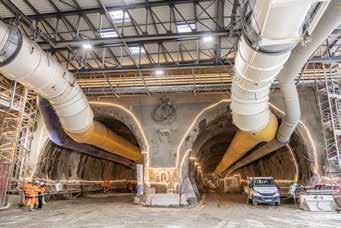
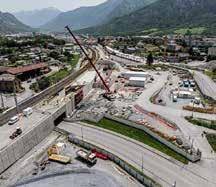
We’ve been witness to a number of major projects over the last 150 years. They’ve all played their part in keeping the valley alive, and the story continues.
Philippe Rollet, Mayor of Saint-Jean-de-Maurienne.
world, so cycling is way up on our priority list! It’s both a major asset and a loss leader for the summer season.»
The Lyon-Turin railway link has inevitably stirred up its fair share of controversies, but it will enable one of Europe’s largest infrastructure projects to carve a foothold in an area that will clearly pounce on every opportunity that comes its way.
«A second project is in the pipeline for 2040 to give France three access tunnels to the railway link that will pass beneath the Glandon, Belledonne and Chartreuse mountain areas. It’s great for raising our area’s profile. We’ve been fortunate enough to witness a number of major projects over the last 150 years, such as the first railway line, dams, and industrial growth. They’ve all played their part in drawing more people to the valley, creating a thriving community and bringing prosperity, and the story continues,» says Philippe Rollet in closing.
* Tunnel Euralpin Lyon-Turin: the public developer created to build and operate the new infrastructure, owned in equal shares by the French and Italian States.
Chief Executive of the Les Sybelles ski resort
«We’ve been following the project with a great deal of interest, since it will help our product deliver greater performance and bring us closer to customers in Italy, as well as customers in Eastern Europe and obviously France. Our investments aren’t dependent on the project’s economic aspects, which tend to be focused on the valley. But when the project comes to an end in 2033, we’ll need to be ready to provide our customers with the best experience, come winter or summer, and keep our mountains thriving all year long. We’re lucky to have an international train station so close to our resorts! That’s where the future’s heading. If customers in tomorrow’s world can leave their car behind, then they won’t hesitate. The only link missing from the chain is a cable car offering direct access to the resorts for both our customers and local inhabitants. We’re working on it.»
A 270 km high-speed railway line (70% of the tracks in France and 30% in Italy)
The world’s longest railway tunnel at 57.5 km
Cost of €11 billion
Up to 4,000 employees by 2026
Handover of the Italian access points: 2033
Capacity of the future Lyon-Turin link: 344 trains a day (freight and passengers)

Since Kohlererbahn in Bolzano in 1908, considered the first mountain cable car for passengers, accessing peaks — which was initially a technical feat — has become a sensory journey. In Les Deux Alpes, Courmayeur, Chamonix and Val d’Isère, new facilities aim to go above and beyond simple transport functionality. Station architecture and development are the subject of large-scale projects, combining aesthetics, environmental issues, and new functions. Some even get a fresh lease of life and are reinvented to offer an increasingly cutting-edge experience, like the former Avaline gondola lift arrival station in La Daille, which is set to reopen as a new branch of the Folie Douce restaurant chain in early 2026 after large-scale renovation work overseen by the Reversade family.
The Austrians are pioneers in this field. For example, in Mayrhofen, a small Austrian tourist town located at the base of the Ziller valley in the Tyrol, architect Helmut Reitter designed the Penkenbahn stations. The ultra-modern departure station with a streamlined, well-lit frontage stands in the centre of the village. Designed as a living space, it offers the opportunity to engage in a range of activities and is set out like a real station with several floors, lifts, escalators, and benches. But the most emblematic project of this kind is unquestionably the Gaislachkoglbahn arrival station located in Sölden at an altitude of 3,040 metres, known worldwide for playing host to one of the latest James Bond films, Spectre. This long and narrow thin steel construction, with its futuristic-looking design, is covered with transparent, resistant plastic film, giving the building a highly ethereal design with no hidden angles and corners. Just next door stands the Ice Q panoramic and gastronomic restaurant, a stack of cubes of different lengths and widths all covered in glass, including a rooftop bar and outdoor seating area. When ski lift design meets Hollywood...

Penkenbahn departure station, designed by architect Helmut Reitter and inaugurated in 2015.
In France, design is increasingly taken into account in station projects. “In the 2010s, we realised in France, even though we’re behind Austria, that stations contributed to customer experience”, explains Johann Sevessand, Architect / Co-founder at ATEAM, which designed the Jandri stations in Les Deux Alpes. “15 years ago, people didn’t “bother” with an architect, but now they’re part of the team with a seat at the table to think about customer service, quality, blending into the landscape including in the summer, environmental impact, etc. Now it has to be attractive and make sense, whereas before we just wanted it to work. It’s set design, intimately linked to architecture. But you have to stay humble and keep in mind that what’s key is the functional side of things, the essential side of the process.”
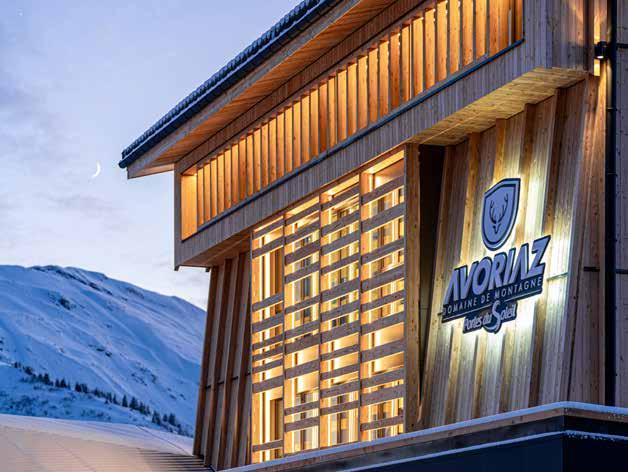
In Avoriaz, the refurbished Prodains 3S Express station has just been renovated by the Haag &
architectural practice. The building is now multifunctional - a trend - and is not only the headquarters of SERMA, but also a bar-restaurant, lockers, offices, meeting rooms and public toilets...
But substance can change with form. This was the case in Avoriaz: in 2013, the original 1961 cable car made way for the 3S Prodains Express; today the renovated station was recently inaugurated to house the offices of SERMA (Société d’Exploitation des Remontées Mécaniques d’Avoriaz, i.e., the Avoriaz ski lift operator). The building, renovated by architects Haag & Baquet, was designed to be more environmentally friendly but also more “social”, featuring a redesigned sales area to be closer to customers and meet their different needs; a panoramic bar-restaurant, the Spot Café; secure, heated ski/boot lockers; public toilets; as well as offices and meeting rooms. Or how the tired old station makes way for a forward-looking facility…

Gaislachkoglbahn and Ice Q restaurant, both immortalised in one of the latest James Bond films, Spectre. ©IceQ_Sunset_byRudiWyhlidal
Architect: Studio DeCarloGualla, Italy
Location: Pila, Aosta Valley, Italy
Equipment: Leitner
Commissioning: Winter 2025-26
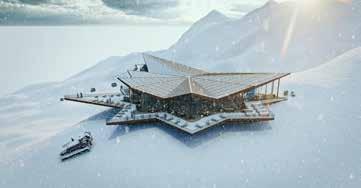
From next winter this next-generation gondola lift will connect Pila (1,800m) to Couis (2,700m) in just 15 minutes, providing one of the most spectacular panoramas of the Aosta Valley upon arrival. For the high-altitude station and its restaurant, Studio DeCarloGiulia designed an alpine star where each point indicates one of the surrounding peaks: Gran Paradiso, Grande Rousse, the Ruitor glacier, Mont Blanc, and Grand Combin. A panoramic viewpoint reaches out into the void, offering a breathtaking spectacle. The project also sets itself apart with its energy efficiency, how well it blends into its surroundings, and the rational approach to its construction.
by La Folie Douce
The La Folie Douce story began in Val-d’Isère at the top of the La Daille gondola lift. It’s here that Luc Reversade, the group’s founder, is pushing the concept further still by buying the former arrival station to expand the venue, which will increase from 4,800 to 5,800m² and offer fresh experiences from next winter. “Compared to our Italian, German and Austrian neighbours, we don’t take customers into account holistically”, he explains. “Of course people want to ski, but also to treat themselves, have fun, and enjoy the view. You have to design the experience for customers of all types, including kids. We’re all about shared experiences.” As a result, kids will be treated like royalty in this village featuring a dedicated ski space, a chocolate workshop, a “fashion kids” corner including fashion shows, and beginners musical composition sessions for aspiring DJs. Parents can visit stores, dance, have a drink and eat in one of the 4 restaurants like the new Café de la Gare, with its atmosphere inspired by the Guggenheim Museum.
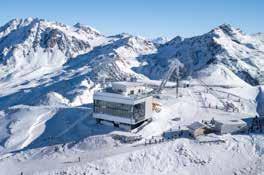
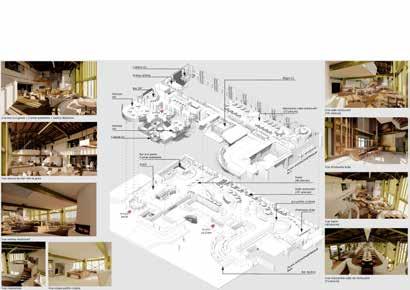
After the gangway and panoramic rotunda, this winter Val Thorens inaugurated the Caron 3200 space, which was designed as a vertical, panoramic, gustatory, oenological, cultural, and emotional experience. A promise equal to this outstanding project implemented under extreme conditions. Created with French government accredited architects and landscapers, Caron 3200 blends harmoniously into the decor, both natural and minimalistic. To limit environmental impact, use of sustainable raw materials, setup of renewable energies and management of water resources added challenges to this exceptional project. The multi-functional building includes a modular room, gift shop, wine bar lounge, restaurant, and rooftop bar with panoramic outdoor seating area.
Architect: Agence ATEAM Architectes, Crolles (Isère)
Location: Les Deux Alpes, France
Equipment: POMA
Commissioning: Winter 2024-25

One of the new Jandri lift stations designed by ATEAM architects.
For this large-scale project, the new backbone of Les Deux Alpes, daring was de rigueur. Johann SEVESSAND, Architect/Co-founder at ATEAM explains: “There were several feasibility studies, the most difficult aspect was finding a concept that could be adapted to 3 stations, from the village to the base of the glacier. We found the right mixture of movement, sizes and crystal skin in three shades, which - depending on interpretation - invoke white flakes and minerals. We used metal, concrete and wood whenever possible, and blended the stations into the landscape and topography as much as possible. It was a crazy adventure, with up to 380 employees on the worksite at the same time and an office trailer at an altitude of 2,600 metres! We had to embrace excess. But there was genuine team spirit between SATA, POMA, contractors, etc. Today, we’re all proud of this achievement.”
Architect: J.Moolhuijzen, C.Baumann (partner and associate in charge)
Renzo Piano Building Workshop, architects
Location: Chamonix, France
Equipment: Doppelmayr
Commissioning: Winter 2026-27
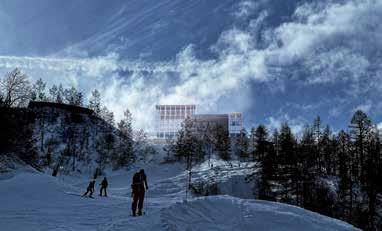
Digital image of one of the new stations designed by architect Renzo Piano in Les Grands Montets. © Renzo Piano Building Workshop
Domaine des Grands Montets in Chamonix is being reinvented with stations designed by the talented Studio Renzo Piano, founded by the renowned architect behind many cultural institutions worldwide, particularly the Pompidou Centre in the 1970s. “The project involves rebuilding the stations and ski lifts, reassessing what building in the mountains means on a site as prestigious as Mont Blanc. The aim is to reclassify the industrial site as a sustainable site and shift perception of ski lifts by transforming passenger transport into a journey.” explain the architects. The four stations are inspired by pyrite crystals, whose structure is made from wood and steel elements. Secondary facilities include reception and service areas, a restaurant, technical workshops, and offices.
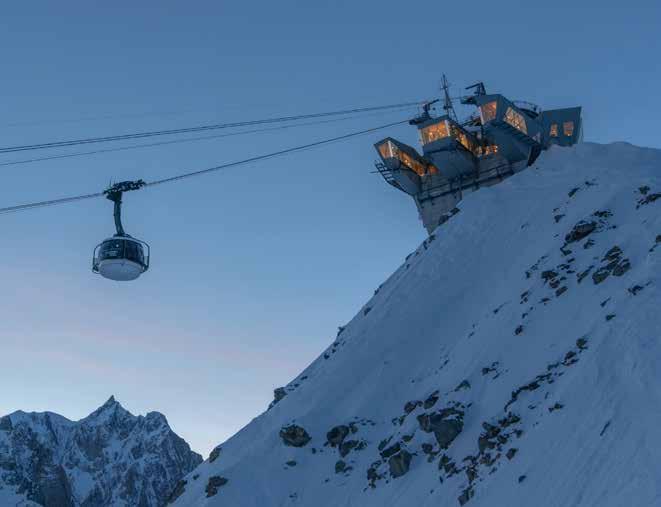
Architect: STUDIO PROGETTI, Genua (IT)
Location: Courmayeur, Aosta Valley, Italy
Equipment: Doppelmayr
Commissioning: 2015
Heading off from Courmayeur, the Monte Bianco Skyway is a technological jewel of the Mont Blanc mountain range. Transparent, 360°-pivoting gondola lifts transport visitors to an altitude of 3,466 metres to Pointe Helbronner in barely 18 minutes. Not only a journey to the heart of the Mont Blanc but also a range of experiences await visitors upon arrival: the Infinity Room with a projection of immersive images, a botanical garden with more than 900 species of mountain plants from all corners of the world, a one-of-itskind sparkling wine aging cellar, the highest book shop in Europe, 2 panoramic restaurants, a cinema, and even exhibitions.
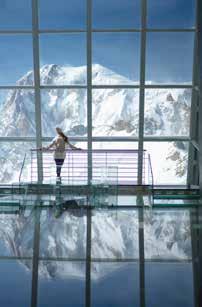
The famous Monte Bianco Skyway, built from 2011 to May 2015 by
FLEXION, REFLEXION



Repair instead of scrapping, dismantle and salvage, buy sustainable and repairable products... for a year now, the resort has been forging ahead with its circular economy policy.
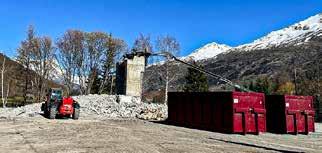
The results have stunned even the most sceptical voices into silence. The Serre Chevalier ski resort in France’s Hautes-Alpes department has managed to cover 34% of its power needs through renewable energies. With that milestone under its belt, the resort doubled down on its drive to promote energy efficiency a year ago by launching another long-term venture aimed at promoting the principles of the circular economy. «We’ve changed our purchasing policy and we’ve gone full recovery mode by repairing what’s broken or salvaging parts to build up a stock of used goods. We also buy products that are more sustainable and repairable,» explains Patrick Arnaud, Chief Executive of SCV Domaine Skiable, a subsidiary of ski resort operator Compagnie des Alpes. These practices have also influenced all the everyday aspects of managing the resort. While Serre Chevalier was thinking about cleanly dismantling the old stations for the Pontillas gondola ski lift to recover the materials, a better opportunity came their way when two customers (including a farmer from the local valley) bought both buildings for a modest sum to transform them into hangars. The ski area made the most of the situation by salvaging the old larch flooring that dated back to the 1960s. «Our carpenters and joiners just love delving into our stock of old boards to make huts and flooring. But you need to remove all the nails and plane the boards. Ultimately, it’s easier buying from the sawmill.» The old liner from a hillside dam has been cleanly removed and transformed into rolls, instead of being ripped up and carted off to the local

recycling centre. Parts of the old liner have been given out to employees, who use it to cover their trailers or the logs for their wood burners. Other resorts are planning to use the liner as a damp-proof membrane in their trenches.
Subsequently, Serre Chevalier went out and bought a 3D printer to make small parts. «We try to choose suppliers who will give us the 3D drawings for the wear parts in their equipment, so that we can reproduce them,» adds Patrick Arnaud.
«The circular economy, the mother of the environmental transition»
Instead of splashing out on a brand new snow groomer, the ski area is thinking about retrofitting an internal vehicle next summer by swapping out a number of parts. The resort has taken the same approach to its access control terminals. Lots of the models are extremely old, but only on the outside, since their circuitry has been replaced. «To avoid changing everything, which means a lot of scrap metal and plastic, we’ve only replaced the PCBs.» When it comes to physical passes, their days are numbered. This winter, visitors were able to gain access to the ski area with their smartphone. «We’re the first resort in France to offer this system. We get through about 300,000 passes. Ultimately, we’ll be able to phase them out completely,» he says enthusiastically. There is no point in spending money to replace the Cucumelle chairlift with a new model. The team is checking with the other resorts to see if they have a chairlift that needs replacing for a faster version or dismantling because it lies next to a glacier. Money is not the main motivation driving all these efforts. «Retrofitting a chairlift costs the same as a new model,» admits Patrick Arnaud. «With the circular economy, you need to be willing to pay more for the same use. Sometimes money can be saved, but not always. It’s a completely different mindset and it’s also good for the planet,» believes Patrick Arnaud. «We should have started with the circular economy. It underlies everything, since you’re not only tackling carbon, but also addressing the planet’s resources, biodiversity and land take. It’s the mother of the environmental transition.»
Initiatives to restore ski pistes and open environments in the mountains.
Read on for an explanation...
Restoring ski pistes involves greening and replanting ski areas to achieve two objectives, the first of which is to make the pistes more visually appealing during the summer months and increase the number of tourists flocking to the mountains. The second goal is to preserve the level of snow cover, bearing in mind that snow adheres better to plants than an earth or rockstrewn piste.
«But growing vegetation on a piste is anything but a walk in the park.The altitude, the countless stones, the extreme weather and the ice breakup at the end of winter tend to carve ruts and furrows into the soil. You also need to make sure that plant species are fit for purpose, meaning that they are capable of withstanding conditions up in the mountains and will fit in with the local endemic species,» explains Laurent Reynaud, Executive Officer at Domaines Skiables de France.
Preserving and restoring the soil in high-mountain pastures is vitally important, not only for giving mountain ecosystems every chance of thriving well into the future, but also for addressing the needs of the different stakeholders involved, especially the farming community.
«We also need to factor in the constraints facing our local farmers. Their herds graze on our pistes, so they’re especially careful about the quality and quantity of the fodder that grows after the snow has receded, since
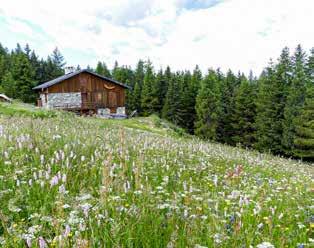
it influences the quality of the milk and consequently the cheese, and even the ability to meet appellation requirements (reblochon, Beaufort, etc.),» adds Laurent Reynaud.
These reasons encouraged Domaines Skiables de France (DSF) to launch a wide-ranging work programme involving various consulting firms and partners from the pastoralism sector, which culminated in a policy for cooperation with the mountain farming community (back in 2014), entitled «Pastures beneath the snow». Environmental commitments were taken in 2020, with several concerning pastoralism. A training module on the operational aspects of rehabilitating high-mountain pastures is currently in the pipeline. The module is being developed by DSF’s Training and Certification division with a target audience including all contractors carrying out works in the mountains, ski lift companies, project management firms, consultancies and businesses.
Environmental commitments were taken in 2020, with several concerning pastoralism.
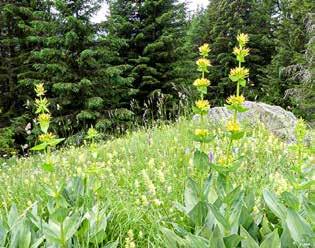
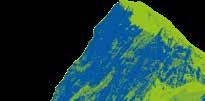
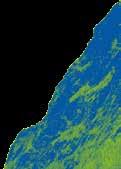
A watchful eye is kept on the natural environment, wildlife and plant life with the aim of producing a snapshot of the local biodiversity...
Environmental observatories act like real climate change watchdogs by closely observing the different plant and animal species, and using that intel to assess how urban planning projects and tourist numbers are affecting the ecosystem. Their mission statement could be summarised as follows: observe to understand, take action to preserve, and communicate to educate. A watchful eye is kept on the natural environment, wildlife and plant life with the aim of producing a snapshot of the local biodiversity, keeping tabs on its changes, and spearheading solutions to protect the sensitive areas identified. Scaling up the number of environmental observatories across the country’s ski areas offers a pathway for adapting practices and combining tourism with environmental protection. “It often happens that local authorities and the State are looking at an inaccurate picture of the wildlife, plant life and even the water resources and natural environment that can be found across any given ski area (except for national parks and special green spaces). That observation prompted our ski areas to push forward with the idea of setting up environmental observatories to provide global insights into how an expansive ecosystem functions and subsequently use these issues to shape the ski area’s longterm development. The ski areas voluntarily engaged with the process,” explains Laurent Reynaud, Executive Officer at Domaines Skiables de France. Back in 2007, the company running the ski lifts in Flaine-Grand Massif blazed a trail by becoming the first ski resort to create an environmental observatory. Its standout initiatives include setting up winter migration sanctuaries for black grouse and rock ptarmigans to shield them from any disturbance caused by the ski area’s users. This example has spawned similar initiatives. “The 3 Vallées ski lift company (S3V) created an environmental observatory in 2013 to improve knowledge, protect the ecosystem and support its decision-making process. The observatory collects and examines data about the ski area’s biodiversity, water resources and natural environment, which are enriched with studies and inventories on plant life, animal life and natural habitats every year. All actions are reviewed every autumn with government services, local communities, economic and social players, and environmental associations,” explains Jordan Fermaut, Environment-Energy Project Lead at S3V. “In 2025, the observatory recorded 25 natural habitats, 9 plant species and 37 animal species, including black grouse, rock ptarmigans, foxes and deer.” These efforts are having a snowball effect, since 69% of the country’s ski areas have decided to maintain an updated inventory of their animal life, plant life, wetlands, wintering grounds, reproduction areas, and so on, which illustrates how ski resorts are increasingly stepping up to the plate when it comes to protecting the environment. NATURAL
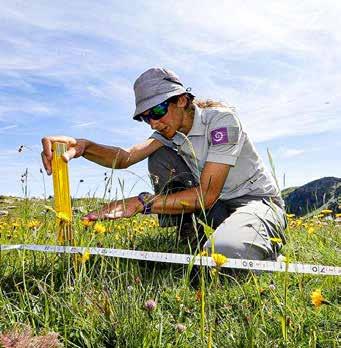
The process, developed by Polyair industrie for Valmorel, has now been rolled out to other skiing areas.
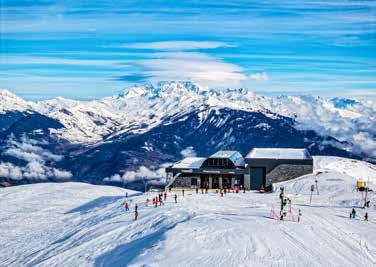
It’s the story of a successful experiment that is being progressively rolled out to other skiing areas. This initiative was launched based on an observation by Luc Carminati, Valmorel’s operations manager. He found it a pity to lose calories from variable frequency drives at arrival stations where the drive section of ski lifts is located. Therefore, he contacted Savoy-based business Polyair industrie, an expert in ventilation, aspiration, air filtration and treatment to find a solution. Challenge accepted.
Polyair industrie found “quite a simple system”, according to its manager, Antoine Henneron. The energy that needs be extracted to make sure electrical systems function properly is transferred using fans to the arrival station’s occupied premises, including control rooms, workshops, and break rooms, preventing consumption of extra power to heat them. Since 2023, Valmorel has equipped four lifts with this hot air recovery process: the La Biollène and Le Mottet chairlifts, the Celliers gondola lift, and more recently the Planchamp gondola lift, the biggest facility. This process is suitable for all lifts. “It’s obviously interesting from a technical point of view and for the planet because it’s mathematical, by effectively reducing power consumption. But ultimately, is it profitable on small lifts? I wouldn’t bet my life on it. But if you forget about the financial aspect, in any case, you save calories”, confirms Mr. Henneron.
It’s obviously interesting from a technical point of view and for the planet because it’s mathematical, by effectively reducing power consumption.
It’s hard to get a clear idea of bottom line and ROI time. “You’d have to measure air flow transfer rate and air temperature and at the same time know what the heating consumption would have been without setting up this system”, underlines the business manager. The skiing area is not in a position to provide quantified data, “particularly feedback on consumption, because measurements were not taken at the time to establish a reference figure.”
In any case, Valmorel seems satisfied with this innovation which has since inspired others. Polyair industrie has equipped over ten lifts in total, including in Les Sybelles and La Plagne.
With their technical capacities, superior comfort, inclusive and enclosed design and all-season capabilities, gondola lifts are seen as an investment for the future as their popularity surges among ski area operators.
In 2024, some €295.2 million was spent on installing 59 new ski lifts, and half that figure alone went on six invariably large gondola lifts. When it comes to the largest investments, top place goes to Les Deux Alpes with its Jandri 3S gondola lift, which took a €51.4 million chunk out of the resort’s €148 million budget. SATA Group, the resort’s operator, is pursuing its ambition of bringing greater connectivity, accessibility and inclusion to all its resorts, while anticipating where future trends are heading. This is exactly what gondola lifts are capable of achieving. “Since we took over the public service delegation agreement to run the Les Deux Alpes resort, we’ve added an aerial tramway, a gondola lift and three hybrid lifts. As part of our Altitude 3300 project, we’re going to build five new gondola lifts in Alpe d’Huez to replace either existing gondola lifts due to their age or chairlifts,” explains Fabrice Boutet, Chief Executive of SATA Group. Many challenges stand in the way, such as the need to sustain business levels in every season and ensure that “we’ll still be working in the mountains in 50 years’ time, potentially with a new range of activities that we don’t know anything about at the present time”, and in Alpe d’Huez, “connecting the entire ski area so someone without skis can get from Villard-Reculas to Auris, and from Vaujany to Huez without having to use anything other than a gondola lift. There’s a real strategy driving this project, which involves creating a link between all our destinations so that nobody is left out, whatever the season.” Second on the list of the largest investments in 2024 are the Le Valléen and L’Alpin gondola lifts in Saint-Gervais (€45 million). Jean-Marc Peillex, the Mayor of Saint-Gervais, has always defended his ambition of connecting “Paris Châtelet-lesHalles to Saint-Gervais Le Châtelet without a car.” Another standout moment in 2024 was the decision to replace the Les Deux Lacs chairlift in Val Thorens with a gondola lift sporting the same name. This new lift provides a direct connection with the Plateau surface lifts and the GrandFond funitel lift, while helping ease congestion on the resort’s other chairlifts. In addition, it offers pedestrian
access to the zip line. This new gondola lift sends out a clear signal of the resort’s determination to cater for children and beginners alike by bringing a greater level of comfort to their journeys and simplifying the boarding and disembarking process.
“Gondola
Anne Marty, Deputy Chief Executive of Altiservice and President of DSF, recently made the decision to replace two gondola lifts in the Pyrenees with two new versions. One of the lifts provides access to the resort from the town of FontRomeu below. “It’s in our best interests to include everyone, even cyclists, and make sure that cars are left behind in the car park in the town centre where they cannot pollute the mountains. There were no alternatives to installing a gondola lift,” she insists. The gondola lift in Saint-Lary has the advantage of taking passengers to one of the highest points in the resort, which has the effect of bringing the mountains within reach of an even wider section of the public, including senior citizens and people with disabilities. People can also take their bikes on board. “Gondola lifts are so inclusive,” advises Anne Marty. “They open up our ski areas to non-skiers, who could potentially become skiers in the future after discovering some of the incredible places in the mountains. Another upside is that gondola lifts aren’t dependent on snow cover. When we decide to move forward with a project, we’re looking ahead over the next 30 or 40 years. None of us knows where the future’s heading.” The resort of Montgenèvre has been brandishing the same claim and firmly believes that enclosed cabins are the way forward. The resort’s operator has been emboldened by the success encountered by its new Rocher de l’Aigle gondola lift (€12 million). Daniel Garcin, director of the company that operates the resort’s ski lifts, advises that this type of lift ticks all the boxes, including safety, a user-friendly design, transport for people with reduced mobility, pedestrians and pets, and year-round operation. Such is the rationale that prompted the decision to replace the Chalvet gondola
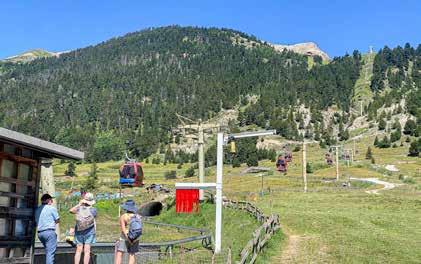
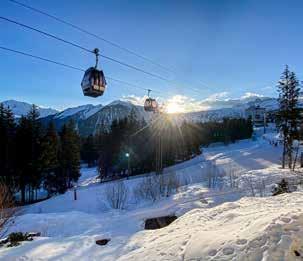
lift and chairlift, and the Fournéous surface lift with two 10-capacity gondola lifts that will follow the same route as the two Chalvet lifts. Estimates put the project at €30 million, with delivery scheduled for Christmas 2026.
The neighbouring resort of Serre Chevalier is also toying with the idea of swapping its Bachas chairlift for a gondola lift to help skiers get back to the resort and overcome any problems with inadequate snow cover. “We’re happy to have seen that customers get into the habit of coming back down to the resort in a gondola lift, even if the piste below is open. In Serre Chevalier, the pistes for returning to the resort are fairly steep, and when the season is coming to an end, they’re not the best place for skiing, especially in the afternoon. This trend bodes well, because we could have periods in the future when there’s no way of skiing back down to the resort if we want to be careful about the amount of snow that we produce. But customers won’t see it as a major hassle,” explains Patrick Arnaud, Chief Executive of SCV Domaine Skiable. Nicolas Chapuis, Deputy Chief Executive of the MND Group, confirms the soaring popularity of gondola lifts. “Over the last two or three years, the trend for oversized gondola lifts has been gaining pace. Five or six years ago, the market featured a fairly balanced mix of chairlifts and gondola lifts. In terms of value, gondola lifts have carved a dominating position in the French market. The reason is that they’re easier to run all year round due to their safety, transport capacity and comfort. They also give operators greater peace of mind because, unlike chairlifts, they’re capable of being used high off the ground and at high altitudes, and fewer towers are needed.”
It is the same story at POMA, the French giant in cabledriven lift systems. Over the last two or three years, Pierre Ract, Chief Mountain Sales Officer for France and Andorra at POMA, has seen the French market take a distinct turn towards enclosed cabins, with gondola lifts representing approximately 70% of the market for new lift investments in 2024. “Most investments in recent years have focused on these highly strategic lifts, whether for taking skiers up to the pistes or acting as a central transport hub within the resorts, and they’ll be in service for 30 to 40 years. They need to carry a lot of passengers, address the challenges of the environmental transition and be designed as a fun and comfortable means of transport, while connecting resorts’ different altitude levels, such as in Courchevel and Alpe d’Huez, and even acting as a valley lift.” Advances in lift technology have simply accelerated the trend. Recent gondola lifts are capable of reaching speeds up to seven metres a second, and the cabins can now be stored in the station when the weather takes a turn for the worse. “A few years ago, provisions had to made for removing the cabins from the line and creating a 100 to 300 m² storage building next to the station, which cost significant money and used up a lot of land,” says Pierre Ract. Gondola lifts are no longer restricted to the largest ski areas, and even mid-mountain resorts are getting in on the act. Pierre Ract mentions Les Saisies as an example, which installed its first gondola lift in 2021, and Crest-Voland is due to follow suit. So gondola lifts really do have a bright future ahead of them.
When she took up her post on 02 October 2024 as the new president of the French Ski Areas Association DSF, Anne Marty expressed her desire to implement a CSR (Corporate Social Responsibility) policy that includes solidarity among resorts. This committee now exists.
In truth, this solidarity is nothing new. Since 2001, DSF has had Nivalliance, an insurance policy against climatic variations, into which each member pays contributions to help those most at risk and limit the financial consequences of accidents resulting from a lack of snow cover. The mechanism establishes solidarity between the world’s unique small, medium-sized and large ski areas. With Winter 2023/2024 proving a very difficult year for low-altitude resorts, €3.8M in support will be paid out to 73 ski lift companies.
At DSF, solidarity is also manifested in the dismantling of obsolete ski lifts, one of the priority actions in its 16 environmental commitments. In 2023, teams identified 70 pieces of equipment that required dismantling across 41 sites. 15 ski tows have so far been dismantled by volunteers from DSF-member ski-lift companies, who covered the human and technical resources required for the operation. The union of ski area operators has fixed a goal of carrying out three dismantlements per year to ensure abandoned facilities do not present a risk to humans and animals, and no longer act as sources of visual pollution. This move becomes even more significant when considered alongside the costs generated by dismantling facilities, which can range from €10,000 to €30,000, depending on their location and type, and the tools and human and mechanical resources required.
Anne Marty hopes to push this concept of solidarity even further. “When a resort makes the decision to close, regardless of how it is managed, its directors find themselves faced with their problem alone. Often, these resorts have little or no permanent employees. Perhaps, if we can anticipate this mountain of debt a few years in advance, and if we can set up a mechanism for village

solidarity, we could, in some cases, at least significantly delay the schedule, if we are unable to prevent their closure altogether”, she explains.
It would be impossible not to think of the L’Alpe du Grande Serre resort in Isère, which owes its salvation, for this season at least, to a wave of solidarity from the mountain universe (ESF, ANMSM, DSF, the French Government, communes, associations, citizen fundraisers, etc.).
In early October 2024, in the face of financial difficulties, Matheysine’s town councillors announced the immediate closure of the resort, but were able to overturn their decision two weeks later by entrusting the SATA Group— which runs La Grave, Les 2 Alpes and L’Alpe d’Huez— with management of the ski area for two years under a

‘régie intéressée’ contract [Translator’s note: a form of public service management in which a local authority entrusts the operation of a public service to a thirdparty delegate], with the option to end the agreement at the end of the 2025 summer season. The SATA Group has provided the small Isère resort with technical and material support for the past three years.
“This régie intéressée contract is a like a two-year miniDSP (délégation de service public). We agreed to the contract with the goal of offering ourselves this time to come up with a long-term project that might motivate them to set up a 20 or 30-year DSP,” explains Fabrice Boutet, Managing Director of the SATA Group.
In reality, the resort has been granted a reprieve until September 2025, the announced date for its permanent closure, unless a sustainable solution can be found.
Once again, the entire ecosystem is involved. “Françoise Gatel, the Minister for Rural Affairs, came to see us, as did the prefect Catherine Séguin,” Mr Boutet continued,
expressing his pride in being able to “get things moving again” and reporting an excellent start to the season, so far exceeding the results of the resort’s record year.
Fabrice Boutet hopes that the group of towns will relaunch a real DSP to which his group will be able to agree and to “no longer have to hold discussions every year to find out what will happen. Bearing in mind that the risks in these cases are borne by the delegate business rather than the Communauté de Communes.”
The managing director sees L’Alpe du Grande Serre as a “testing ground for all lower mountain resorts”, and an opportunity to try out a wide range of ideas, based not only on skiing, but also on hiking, cycling and contemplation. Capitalising on skiing would be a great first step, reconfiguring slopes, setting up a ski lift to create a ski area at an altitude of 1850 m, with good snow and sun exposure guaranteed.
An ideal location for a beginner’s area. This ropeway could also be used in spring and summer, bringing in not only skiers but also pedestrians, the elderly and people with reduced mobility, who would be able to enjoy an “incredible panorama” if a number of walking or hiking routes were created, for example. Fabrice Boutet sees L’Alpe du Grand Serre as a “climate refuge at the gates to Grenoble”. Why not organise the resort so it can be enjoyed in the late afternoon, evening, or even overnight?
Only time will tell whether these efforts will pay off and ensure the region’s economic survival.
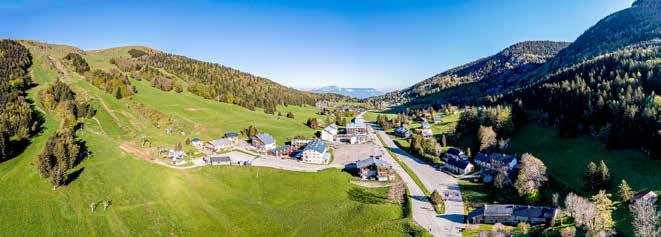
“Our members include all types of businesses, the vast and beautiful alpine resorts, that act as an international showcase, as well as very small resorts which, at a regional level, weigh very heavily economically and socially. That’s why these regions are still functioning,” explains Anne Marty.
L’Alpe du Grande Serre is far from the only resort currently having to make predictions about its future, confronted with difficult decisions and needing to think fast on its necessary transition.
Resorts need support. They need to learn from the experiences of others to reflect on their short, medium and long-term evolution. It was in part for this that the DSF’s new solidarity committee—chaired as it happens by Fabrice Boutet—was created. “We can also help them create master plans for transition. Every time we bring an application to government departments, it’s incomplete. We need to be able to demonstrate a long-term vision, what the goal is when requesting new facilities, whether they be ski lifts, water tanks, footpaths or mountain biking paths. This is another area in which large resorts have expertise,”
Mr Boutet emphasises. As no major decisions are made without elected representatives, this committee will be able
to help clarify the visions each resort has for its region. “That’s what we did with Autrans - Méaudre-en-Vercors. “I went there with my director of operations and asked them about their vision for the region to find out what we could do there.”
Solidarity can also mean helping small resorts put their environmental commitments into action. “The type of administrative, human and material support we are able to put in place to help a destination respond to issues related to transition, technology, large-scale maintenance, preparation and securing of slopes, and even fiscal and social projects,” explained the committee’s president. All free of charge, donating our time, logistics and technology. Fabrice Boutet has experience with giving small resorts a helping hand. And not to mention the L’Alpe d’Huez mechanics who hurried to the Col de Porte to repair a snow groomer, as well as the teams from Les 2 Alpes sent to Mount Aigoual to change the cable on the surface lift, and the electricians from Les 2 Alpes who went to solve an electrical issue on a surface lift at L’Alpe du Grande Serre. Who can always count on the collaboration of the SATA Group.
Solidarity can sometimes manifest in the way a ski resort is managed. A few association-run resorts still exist in France today, notably in Isère, where they weather the storm thanks to the actions of local residents who have teamed up to sustain the life of their surrounding mountains, keep a number of socio-professionals in place, ensure skiing remains accessible, and train the skiers of tomorrow. Part of the Saint-Hugues-les-Egaux ski area in Chartreuse has been managed by around 15 volunteers since 2012. Offering Nordic and alpine skiing and culminating at an altitude of 950 m - 1100 m, this small resort is aimed at families and beginners. It is run by a team of multi-talented staff according to a well-established structure, where everyone is ready to lend a hand, such as the farmers who come to groom the slopes in the summer, to remove cow dung from the cross-country area, or even to repair broken surface lifts. The Grand Plan resort, located in the Belledonne mountains of France at an altitude of 1360 m, was created by locals to enable their children to ski and has been managed by volunteers since 1974. Today, the area is run by some 400 voluntary staff, who, driven by the desire to make skiing accessible, often follow in the footsteps of previous generations of their families. Prices at the resort are among the lowest available in France, and a year-round pass costs just €50 for adults and €40 or less for children.
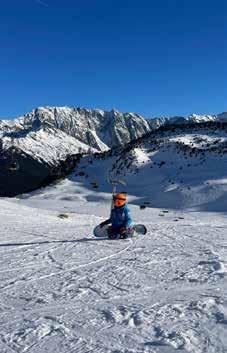
With memories still fresh in its mind of how the Northern Alps prospered from the Olympic Games over 30 years ago, the Hautes-Alpes department is expecting no less of a windfall when it plays host to the freestyle events of the 2030 Winter Olympics. The authorities are counting on their ability to improve local housing, access and service infrastructures.
Not a single business, sports or political event goes by without a regular reminder that Hautes-Alpes will be setting the stage for the 2030 Winter Olympics. This microcosm has spent years in eager anticipation of hosting such an event and relishing the prospect of affirming its identity, shining on the international stage and fast-tracking development projects in an area that has been left somewhat on the sidelines in the country’s urban design programmes. The event will give Hautes-Alpes a chance to put an end to the loathed comparisons and confusions with its neighbouring departments, i.e. Savoie, Haute-Savoie and Isère, and reap similar benefits to what they enjoyed during the Winter Olympics in Albertville. “We’ve spent the last 30 years telling people that the Winter Olympics were held in Savoie. The 1992 Games were a gamechanger for that department, and now we’ve been given the same remarkable opportunity,” says Arnaud Murgia, Mayor of Briançon.
Hautes-Alpes is forging ahead in bridging the digital divide across the department, but it is a completely different story when it comes to mobility. History has been a litany of missed opportunities. The region is easily connected to the south by the A51 motorway, but locals have abandoned any hope of ever seeing the motorway extended through their department to reach Grenoble. Inhabitants need the patience of saint when driving along the narrow roads that snake their way through the mountains, without forgetting the traffic jams that clog the roads during the height of the season and the hazards inherent in the area’s geological structure. Gap and Briançon are separated by a mere 87 km, but it takes close to 90 minutes by car to make the journey, and that is when conditions are ideal. As for the train, the situation goes from bad to worse. Passengers are looking at a marathon 4.5 or 5-hour ride to get to Marseille from Briançon on a diesel-powered train.

Since 93% of the competition venues already exist and bearing in mind that the French Alps bid sings the virtues of energy efficiency, “investments will not so much focus on the Olympic venues as they will on building accommodation and transport infrastructures,” explains Dominique Dufour, Prefect of the Hautes-Alpes department.
In Montgenèvre and Serre Chevalier, the two host resorts that will set the scene for the freestyle snowboarding and skiing events, development work is expected to be restricted to upgrading the pistes, parking areas and snowmaking equipment, as well as changing a chairlift. This means that efforts will mainly be directed at improving access and facilities for athletes and visitors. Politicians and business leaders have been
According to the authorities in Hautes-Alpes, some €200 million will be needed to upgrade the department’s roads over the next five years.
mulling over the issue for months and holding regular meetings, with each side coming along with its own wish list. The BTP 05 federation of construction professionals has set its sights high by putting together a €1.2bn project roadmap to prepare for the Winter Olympics. “The department has been overlooked for decades, so it’s a case of playing catch-up. It doesn’t possess the road or railway infrastructures that are worthy of an area that welcomes tourists all year round and which will soon host a global event of this magnitude,” says the federation’s chairman Nicolas Chabrand in justifying the investments.
According to the authorities in Hautes-Alpes, some €200 million will be needed to upgrade the department’s roads over the next five years. “We need to inject greater safety, reliability and robustness into the service infrastructure for the Briançon area and also the local and international routes linking the different Olympic competition venues. Special attention will be paid to the RD1091 B-road between Grenoble and Briançon, and the RD942 and RD900B B-roads between Tallard and the RN94 A-road through the Avance Valley. Work will also focus on increasing safety and reinforcing the RD1075 between the Southern Alps and the Northern Alps,” explains Jean-Marie Bernard, President of the HautesAlpes Departmental Council. He sees the Winter Games as a unique opportunity to ramp up safety on the roads entering Hautes-Alpes, which are prone to landslides and rockfalls, “since the infrastructures in our department have never been geared towards an event of this scale.”
The Provence-Alpes-Côte d’Azur region has promised to lend its support in modernising the transport system, especially the railways, by accelerating renovation work
on the Veynes railway hub to guarantee a journey time of 3.5 hours between Briançon and Marseille. Depending on how the scenario plays out, railway operator SNCF has estimated a cost of between €300-900 million.
The Olympic Village built at an unused fortification site in Briançon
When it comes to accommodation, expectations are running just as high in the north of the department, which is struggling to provide housing for its permanent residents and seasonal workers, since land is at a premium and therefore expensive. The authorities are toying with the idea of converting the Three Heads Fort, which stands in a former military site overlooking the city of Briançon, to house the 1,200 athletes competing in the Hautes-Alpes events and their staff. This solution would actually solve two problems in one go. Firstly, it would provide much needed accommodation, and secondly it would take a weight off the authorities’ shoulders by giving a new lease of life to a site that has continued deteriorating since it was abandoned by the army. Given that it sprawls over an area of 20,000 square metres, the site offers a wealth of opportunities. Once the Games are over, the Olympic Village will be transformed into a district, complete with shops, services and amenities, while prioritising efforts to help first-time buyers onto the property ladder and provide housing for seasonal workers.
As part of the determination to improve the 2030 Games’ green credentials, the programme includes provisions for creating cable car access to the future Olympic Village from the city below. The cable car system would also be connected to the competition venues to reduce emissions and relieve congestion on the roads. The road between Briançon and Monêtier-les-Bains is expected to be widened with an extra lane for public transport. “The Three Heads Fort is a military site, so it also features its own road network. Those roads are currently private, but they could potentially be repaired for use as soft mobility lanes,” adds Dominique Dufour.
Rome was not built in a day, and completing all these projects in only five years appears to be tall order, especially since the wave of unrest sweeping the country’s political system, the struggle to get budgets approved and the difficulty in designating an Olympic Organising Committee and the company responsible for delivering the Olympic structures and equipment are putting the process behind schedule.








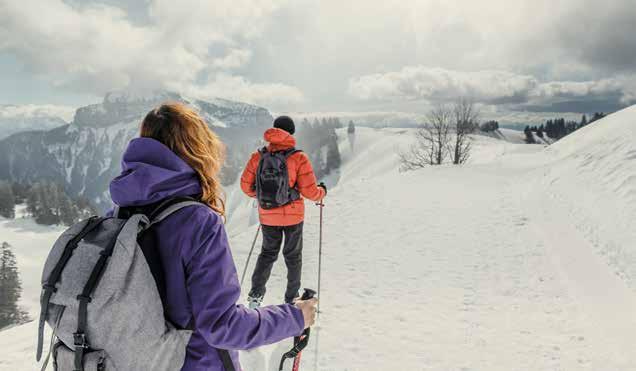
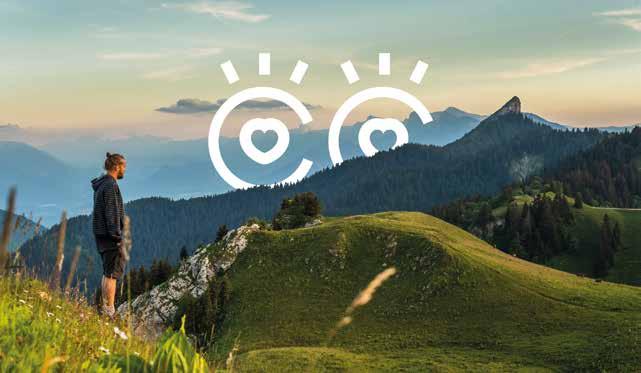

Fabrice Pannekoucke President of the Auvergne-Rhône-Alpes Region
“The Olympic Games have arrived in an era of responsibility, cooperation and understanding”
The newly appointed president of the AuvergneRhône-Alpes region discusses the opportunities offered by the 2030 Olympics and his approach to organising the event.
What sort of legacy are you hoping will come from the 2030 Olympics?
Our bid was part of a shared vision with the IOC to hold an Olympics focused on sustainability. We believe there is no better place nor a more beautiful location for this objective than the French Alps. Twelve of the thirteen infrastructures built for the Albertville Games are still usable today. They will be reused for the 2030 Winter Olympics and Paralympics. The French Alps also boast a decarbonised
transport network, with seamless integration between rail and public transport.
In terms of economic legacy, a study by the independent office Asterès, published in September, confirmed that the 2030 Winter Olympics could generate almost 50,000 jobs for the entire French territory.
In terms of environmental legacy, we will notably work on decarbonising our transport solutions. All of these goals have been reflected in the bid promoted by Renaud Muselier and Laurent Wauquiez since 2023. These Games, which we aim to ensure are inclusive, will above all be an opportunity to shape the mountains of tomorrow. We face many challenges, but they represent an opportunity we will be able to seize together.
You recently travelled to Salt Lake City to meet with the organizers of the 2034 Olympics. Are there practices there that the Alps will be able to take inspiration from? What we saw in Salt Lake City was very inspiring. The use of infrastructure dating from 2002 has encouraged has to continue the Olympic legacy present in the Alps, the birthplace of the Winter Olympics. We were able to see a long-term heritage strategy, with infrastructure adapted to the needs of residents after the event. This is an important lesson for France, particularly in our mountain regions. In Salt Lake City, we saw how the Games can act as a lever for boosting the local economy, developing useful infrastructure for the population and strengthening touristic appeal, all while respecting the environment.
You are in the process of setting up a working group with Milan Cortina 2026, Salt Lake City 2034 and the 2038 Swiss Project. How important is it to move away from the francocentric perspective for the 2030 Olympics?
In a similar vein to our desire to make a joint bid with the Provence-Alpes-Côte d’Azur region, it seemed only natural for us to want to set up this movement to share experiences. We’re very much team players in AuvergneRhône-Alpes! The goal is not to abandon the French perspective, but simply to discuss the common issues encountered by organizers. We are far from the traditional race for unbridled expansion and out-of-control budgets. The Olympic Games have arrived in an era of responsibility, cooperation and understanding.

A Salt Lake City, nous avons vu comment les Jeux peuvent être un levier pour dynamiser l’économie locale
In Salt Lake City, we saw how the Games can act as a lever for boosting the local economy
At the EUSALP (EU Strategy for the Alpine Region) summit in Slovenia, you called for a European mountain pact. Could you explain what you mean by that?
At the EUSALP General Assembly, I was given the opportunity to talk on the subject and offer a reminder of our ambition in Auvergne-Rhône-Alpes to create a “European mountain pact”. Mountain regions, who have their own economic, social and environmental concerns, require special recognition in European policies and suitable resources.
I believe EUSALP should promote inter-alpine cooperation to prepare the coming editions of the Winter Olympics in Alpine regions, from Italy in 2026 to France in 2030, and potentially Switzerland in 2038. We need to work on shared objectives, to ensure the new model for the Winter Olympics held in the Alps boosts the dynamic of transition in Europe’s mountain regions, looking beyond 2030 and taking into account issues such as environmental transition, sobriety, and youth engagement.
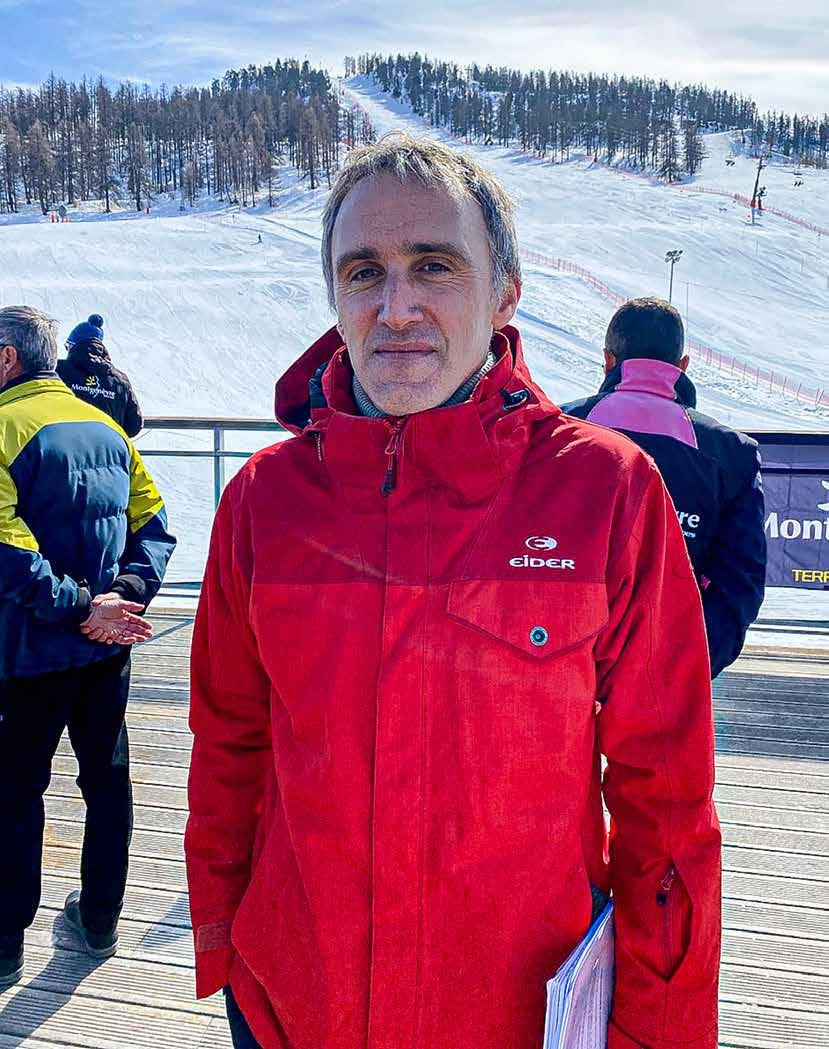
Damien Robert
Managing Director of Solideo 2030
“Most of our efforts will need to be focused on minimising our footprint”
The head of the company responsible for delivering the infrastructure for the 2030 Olympics shares his vision for the Winter Games in the Alps, an event that should leave a lasting legacy for the host regions while keeping the carbon footprint of the construction work to a minimum.
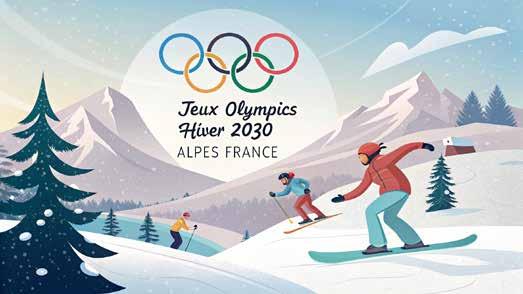
How many sites need to be renovated or built?
At this stage, we’ve identified around thirty structures. 90% of the facilities to be used for the Games already exist but need renovating. Most structures already exist but need renovating. In terms of accommodation, there will be four villages providing nearly 1,000 accommodation units. These will combine new builds and the refurbishment of existing buildings. We’ll also need to build or upgrade infrastructure (such as footbridges, roads, etc.) to improve accessibility between the competition venues and the future villages.
How do you go about creating green and sustainable Games?
Every time construction work is necessary, it must be carried out with a focus on minimising our environmental impact, whether in terms of materials and their transportation, the energy used or protecting biodiversity: wildlife, plant life and water resources. It is also essential that our projects benefit the local economy.
You place a strong emphasis on the issue of legacy...
All the structures that we deliver will have a life beyond the Olympic and Paralympic Games. Most of them have already had a history and a use since we’re mainly working on renovations. We must carefully consider their development by anticipating their future use, particularly in terms of people in the local area, whether they are
tourists, seasonal workers or permanent residents. It is also crucial to ensure that, after the Games, the accommodation we create (a total of nearly 1,000 new or refurbished units) responds as closely as possible to the needs of the region. This means carefully planning an appropriate and mixed range of residential property including social housing, retirement housing, seasonal accommodation, tourist accommodation, etc. The regions know their own needs, which is why it is essential to work closely with the local authorities.
How important will innovation be in all these projects?
As was the case for Paris 2024, a significant part of the budget will be allocated to innovation. But I don’t believe in innovation at any cost, to be effective, we must pick our battles. I think that most of our efforts will need to be focused on minimising our footprint
What do you think the future of the mountain looks like and how can the Olympic and Paralympic Games accelerate that transition?
To answer that, I’ll willingly quote the President of Provence-Alpes-Côte d’Azur, Renaud Muselier, who summed up the challenge: “We’re building the Alps of 2030 to shape the Alps of 2050.” And I’d also quote the President of the Organising Committee of the Olympic Games, Edgar Grospiron: “The Olympic Games won’t resolve everything, but they can be a catalyst for transformation.”
Since 1974, the Grenoble event park has organized and hosted, every two years, the largest international gathering of professionals from the mountain world. The diversity, representativeness, and quality of the exhibitors make this trade show a unique global crossroads, a place for business, exchanges, and an essential forecasting platform.
Mountain Planet 2026 will once again be the center of French and international ecosystems to address the future challenges of mountain development and rejuvenate its various sectors.



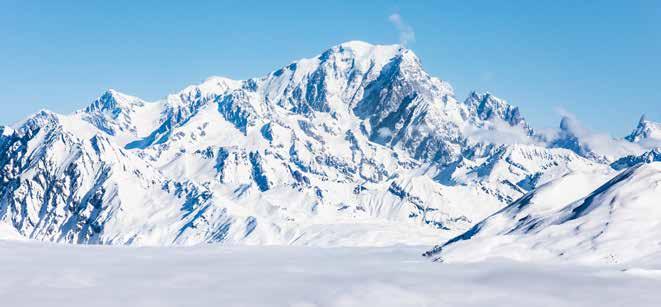
MEMBERS OF THE RESTRICTED COMMITTEE CO-CHAIRS
ALPEXPO – ANEM – DOMAINES SKIABLES DE FRANCE – ANMSM
MEMBERS
AFMONT – GRENOBLE CHAMBER OF COMMERCE – SAVOIE CHAMBER OF COMMERCE –CLUSTER MONTAGNE – AUVERGNE-RHÔNE-ALPES REGION – DOPPELMAYR – KASSBOHRER – LEITNER –MND – MONTAGNE LEADERS – POMA – TECHNOALPIN - FRENCH TECH IN THE ALPS
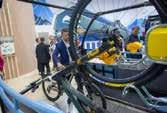






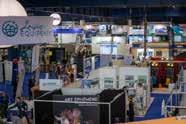

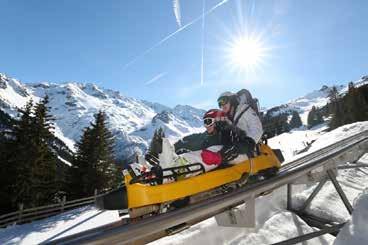





Operating comfort and reduced environmental impact with LIFE, the POMA detachable station co-developed with cable car operators.
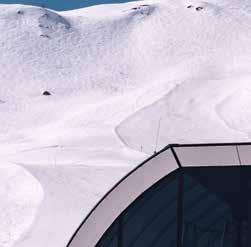






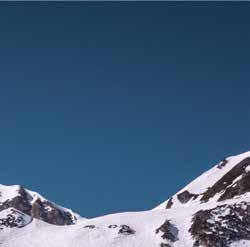
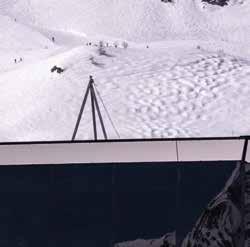

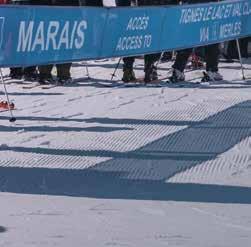
























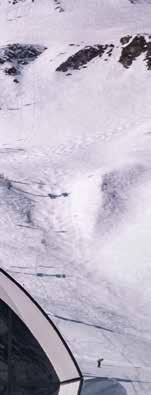

CHAIRLIFT MARAIS - TIGNES FIRST LIFE DETACHABLE STATION
